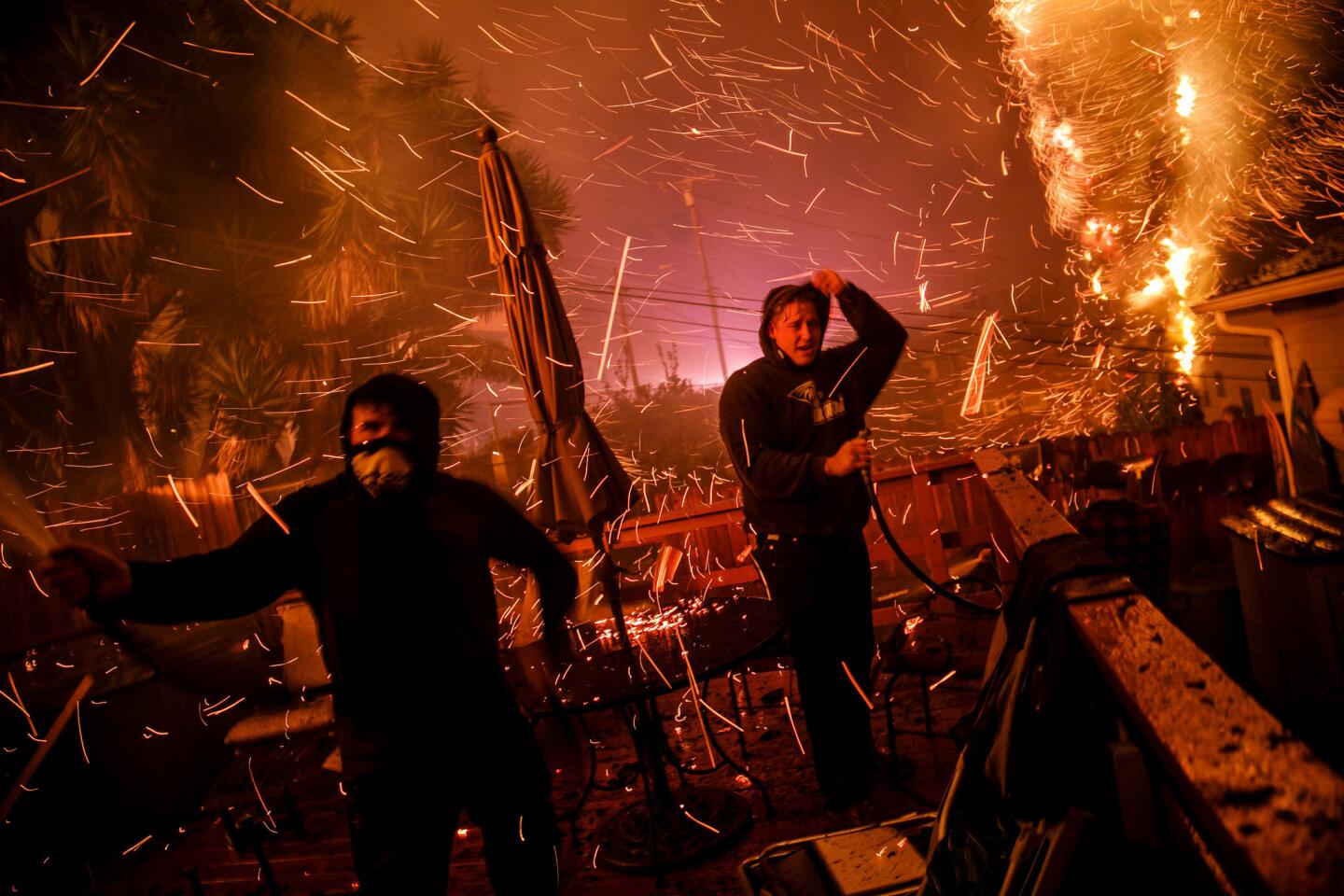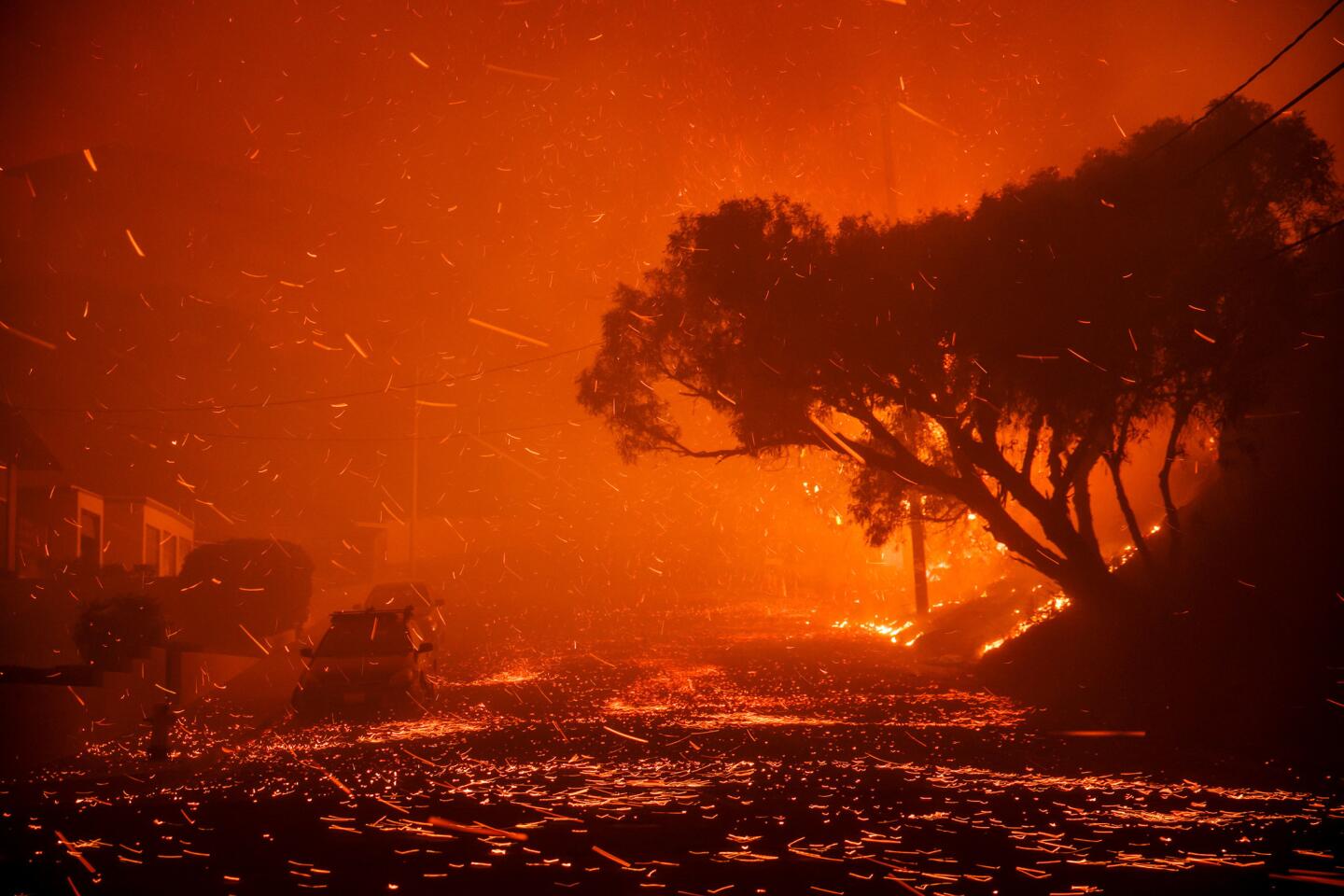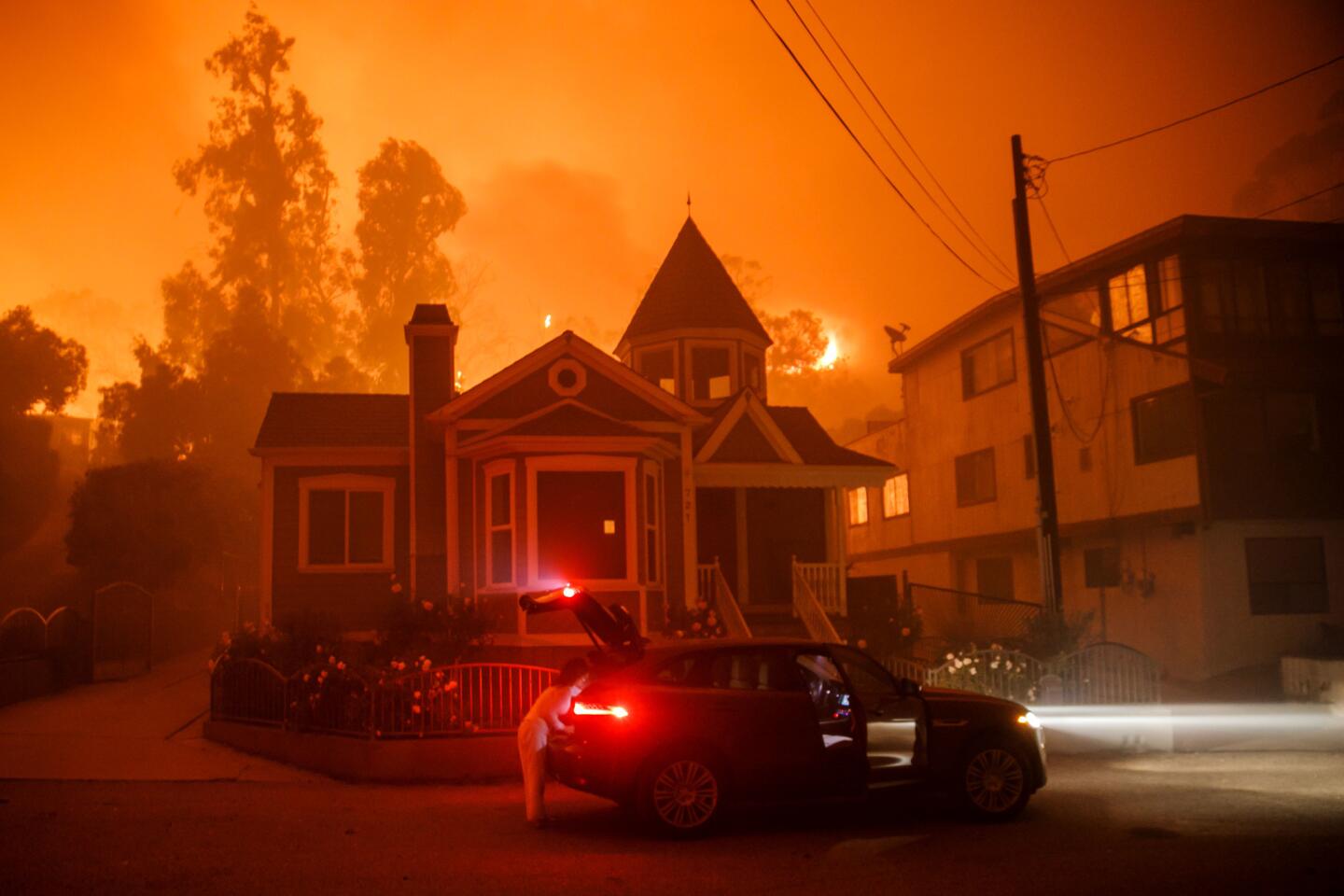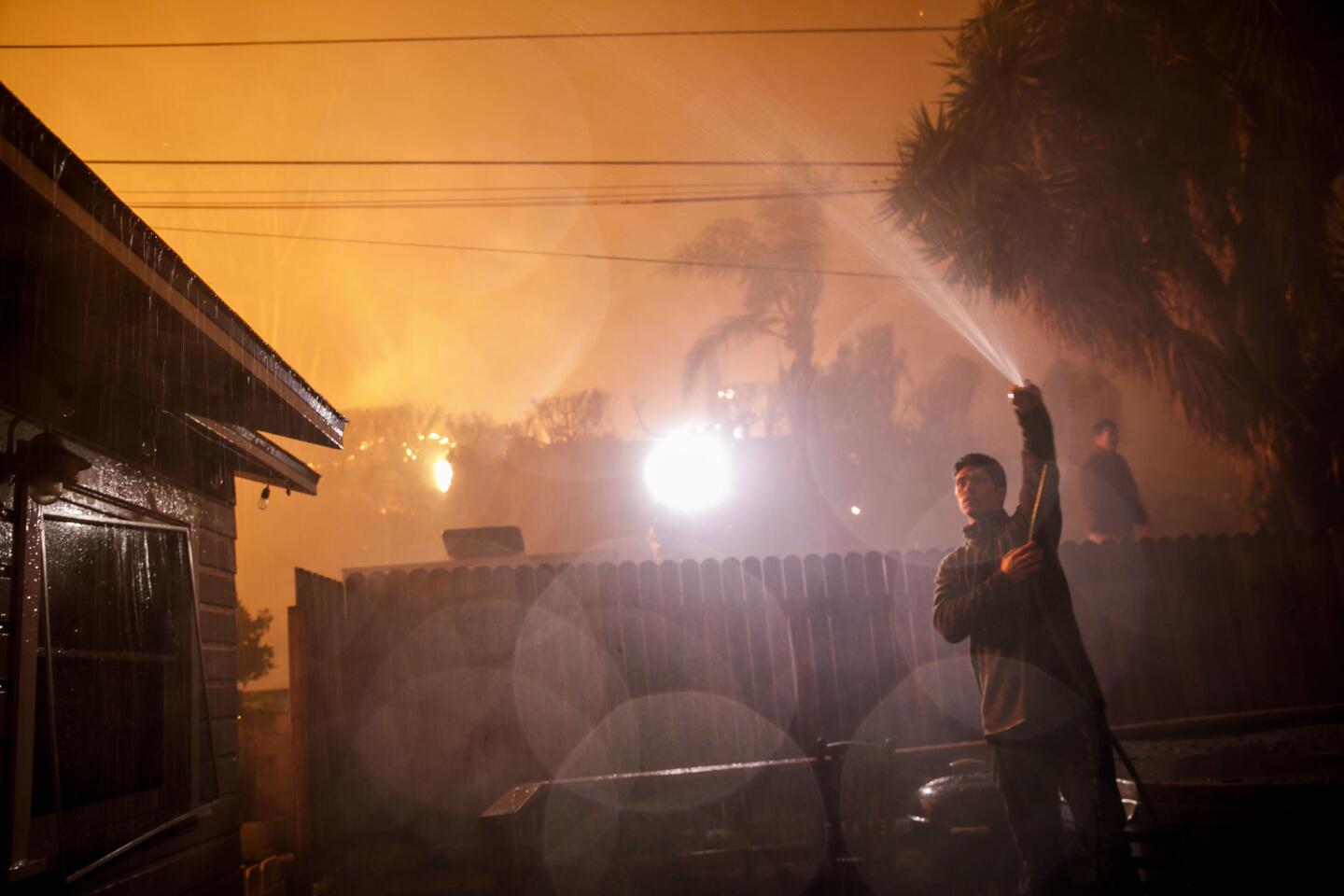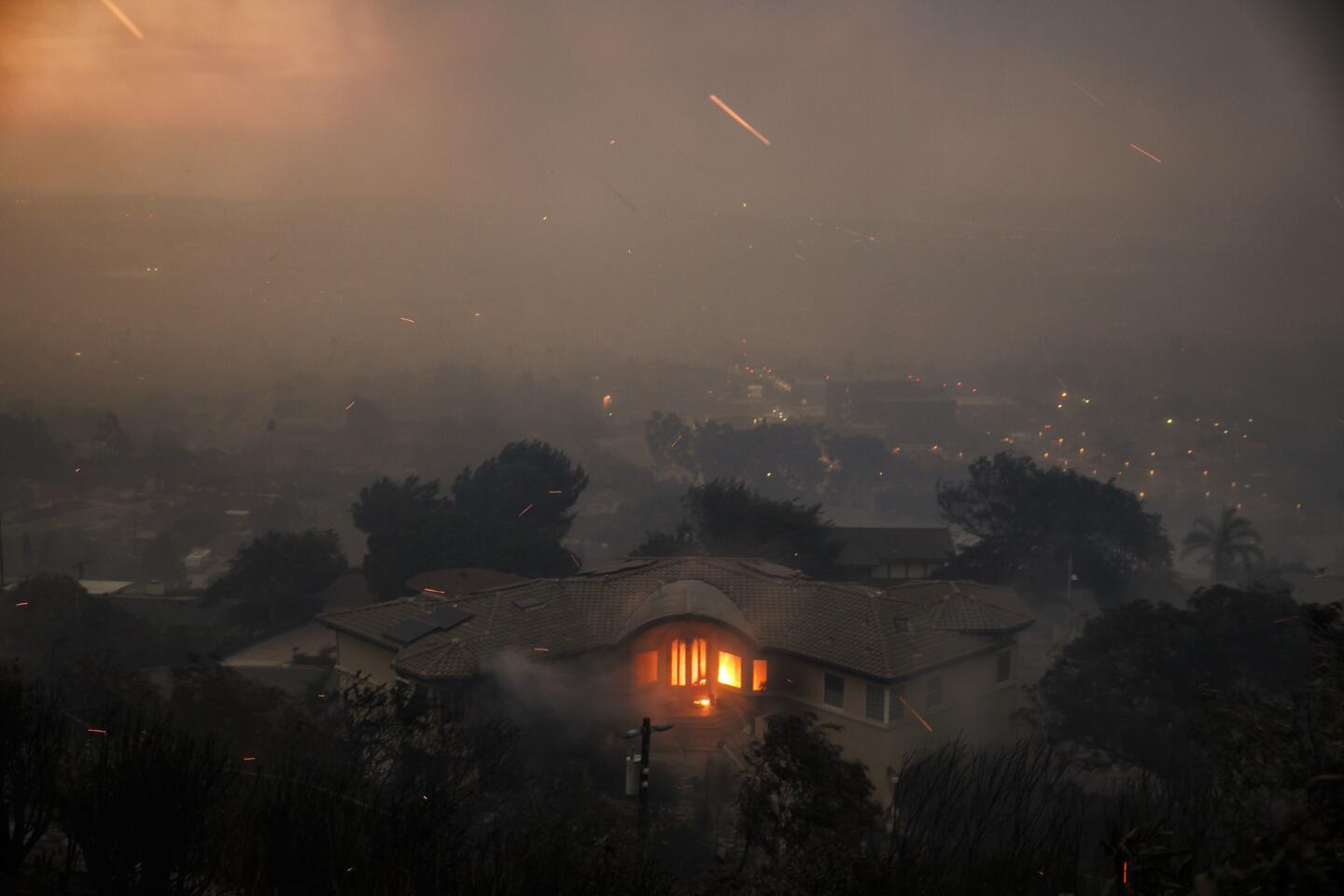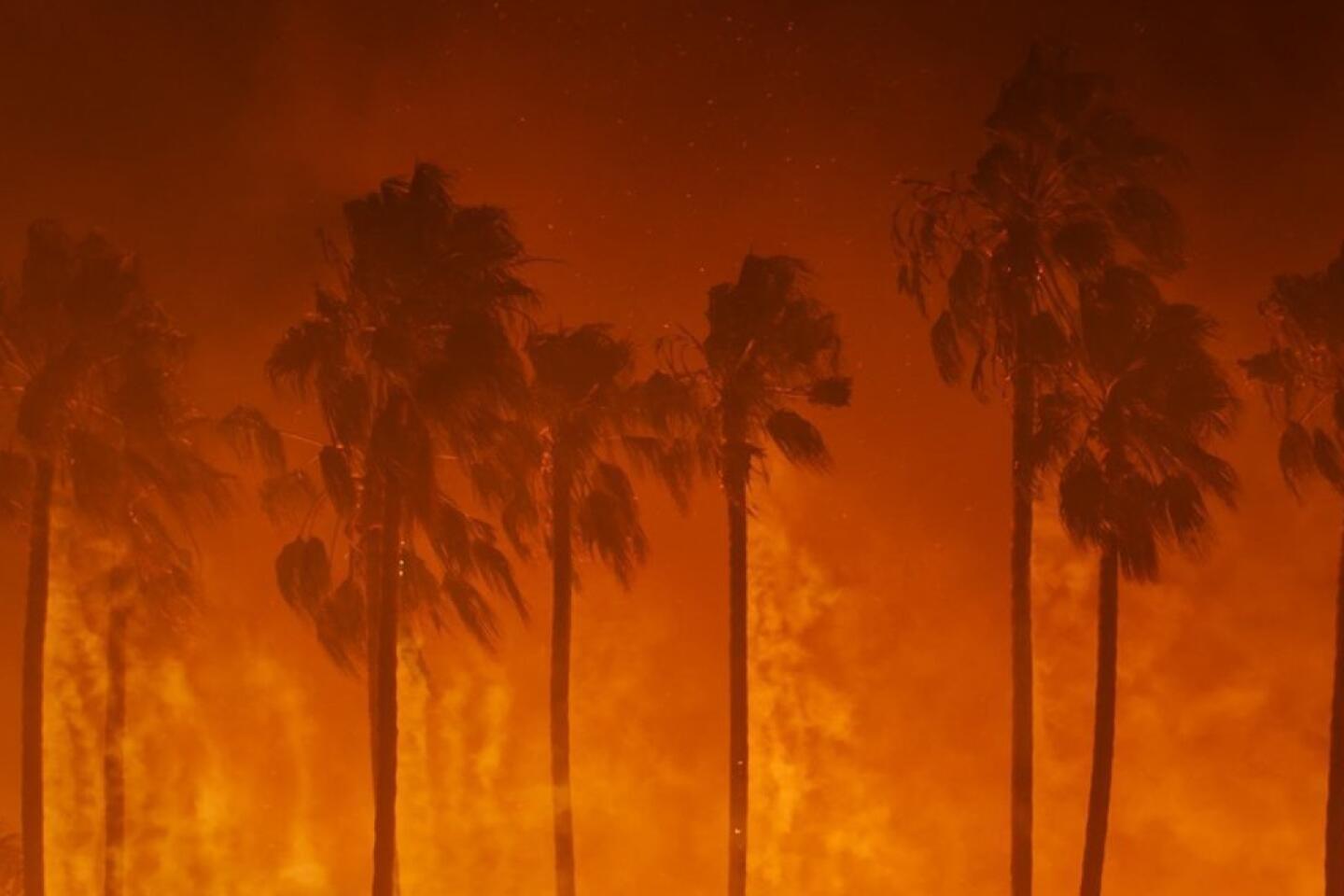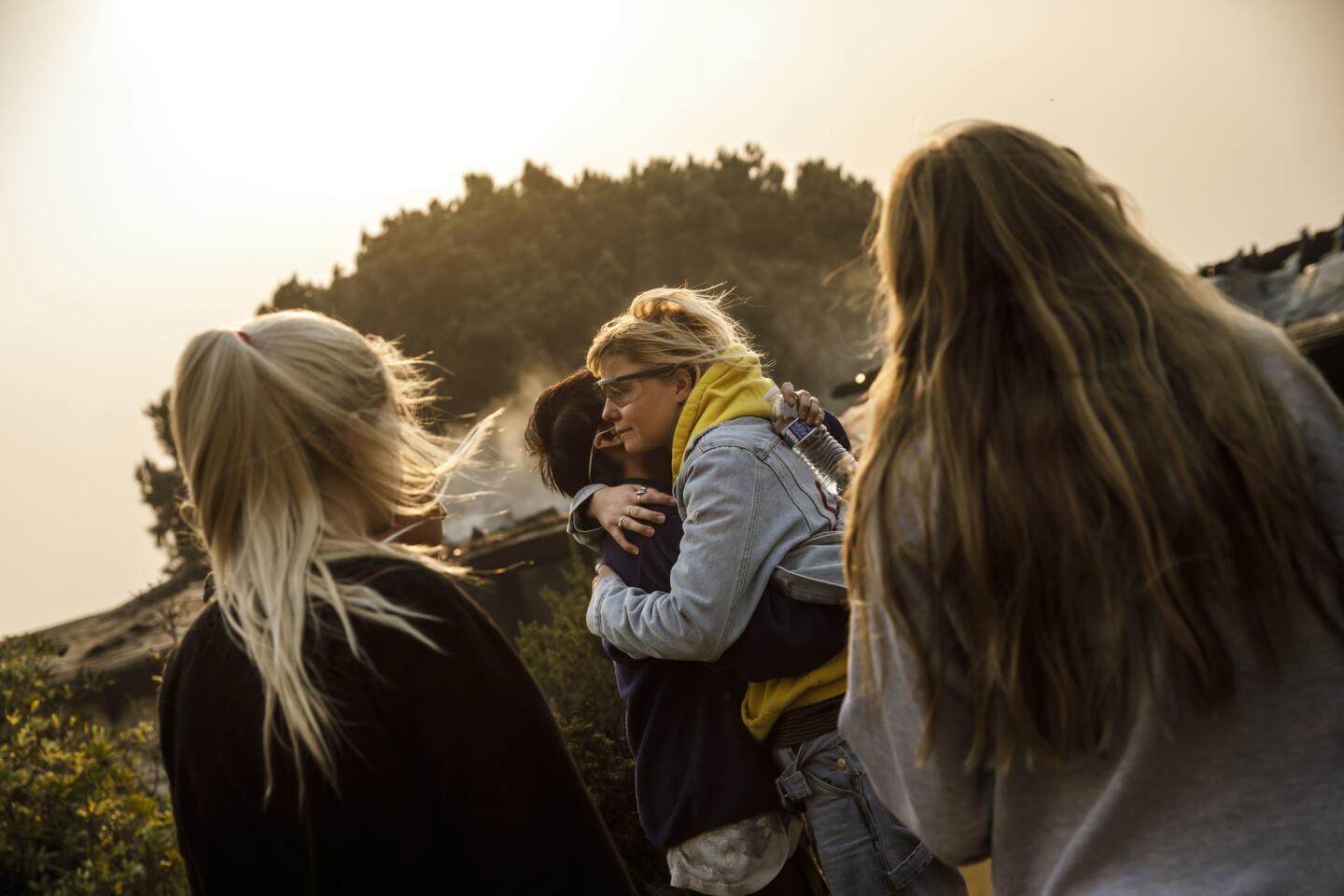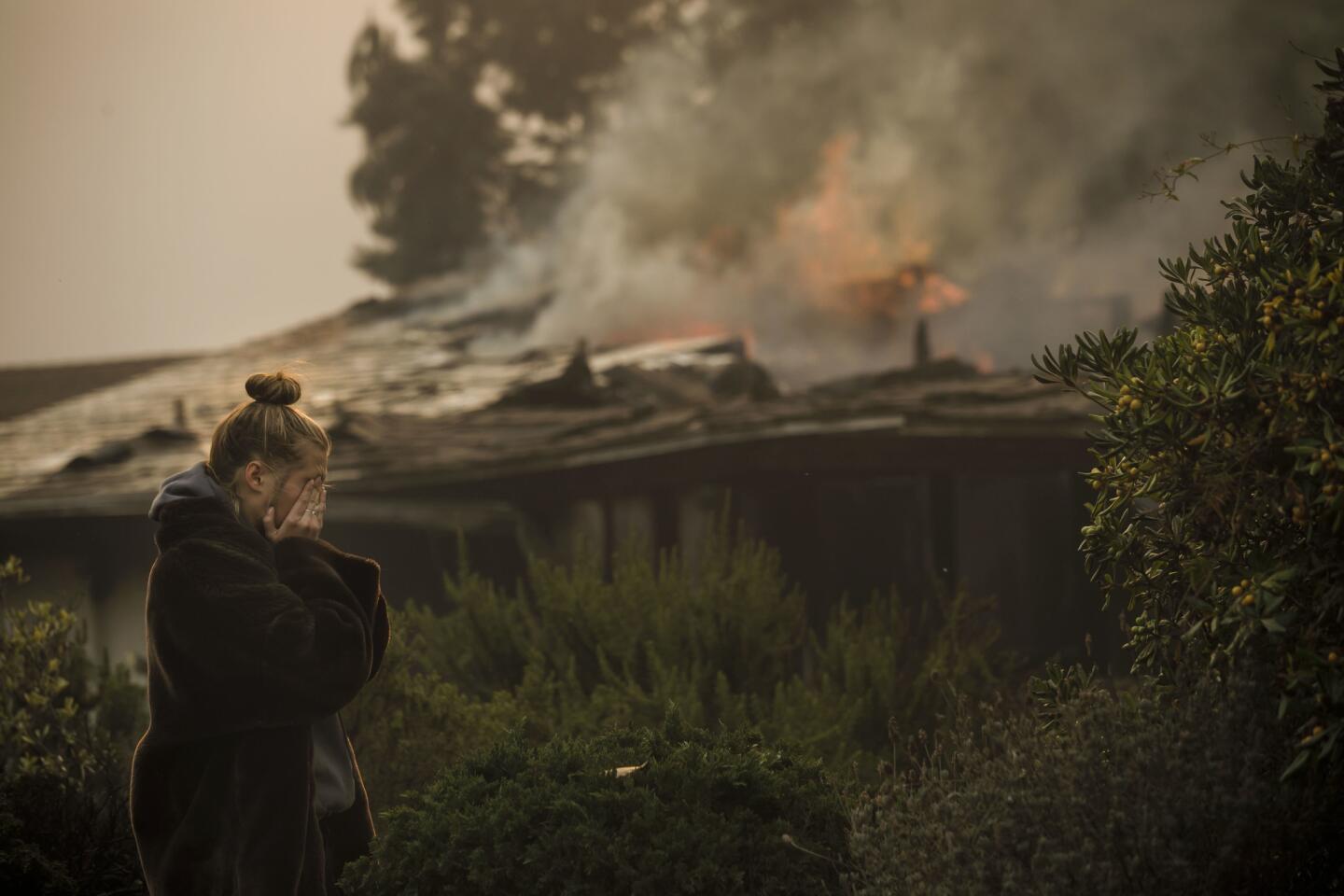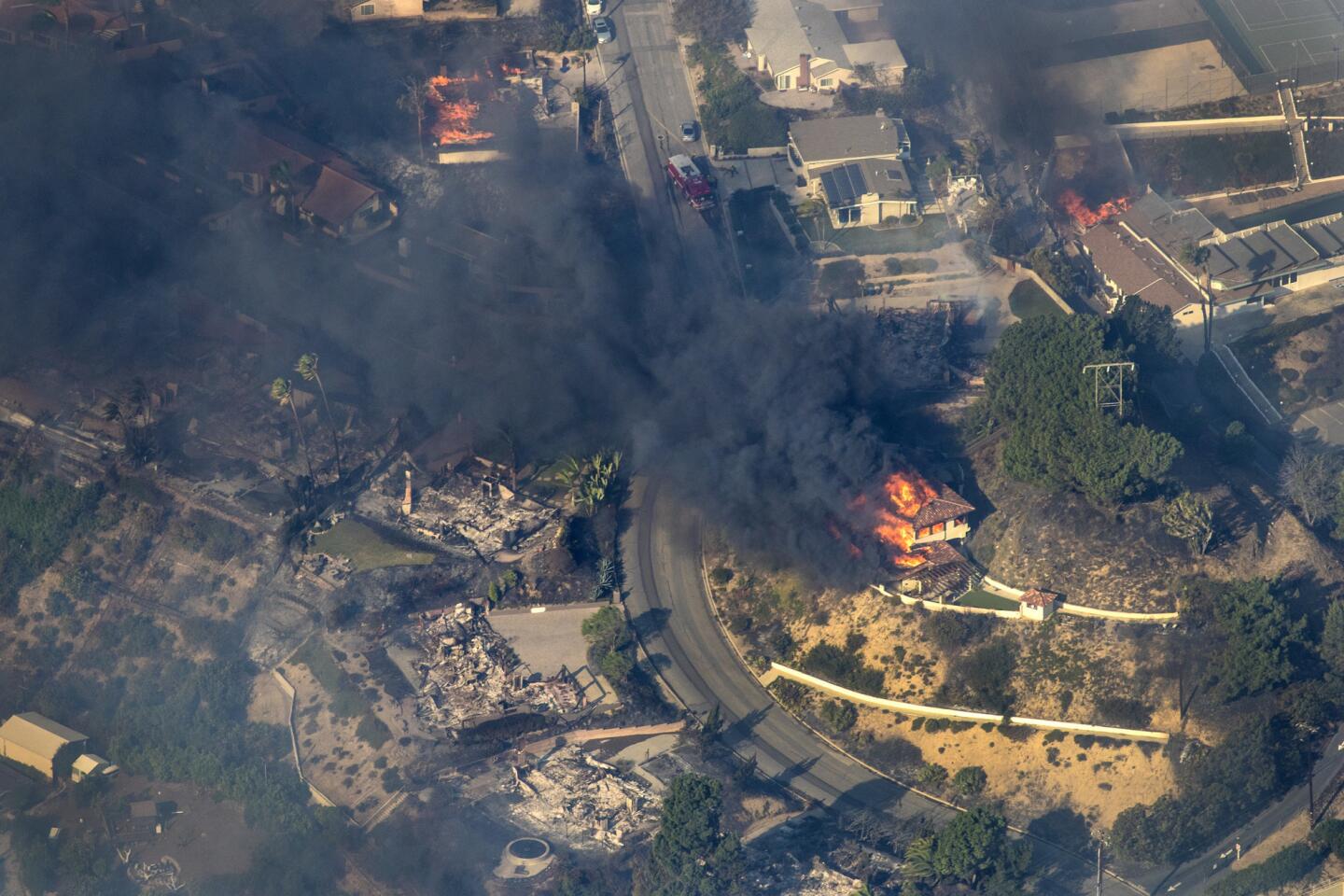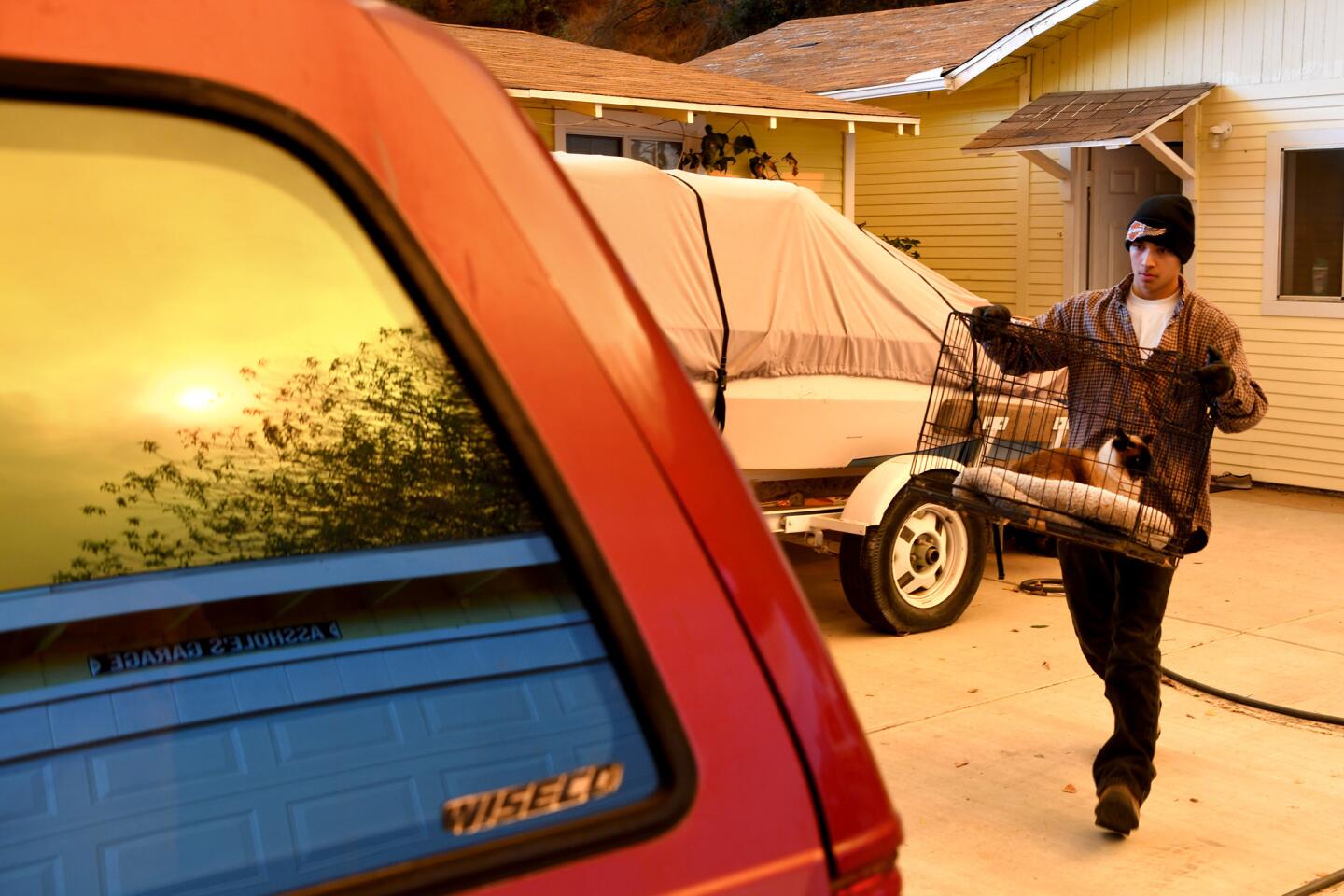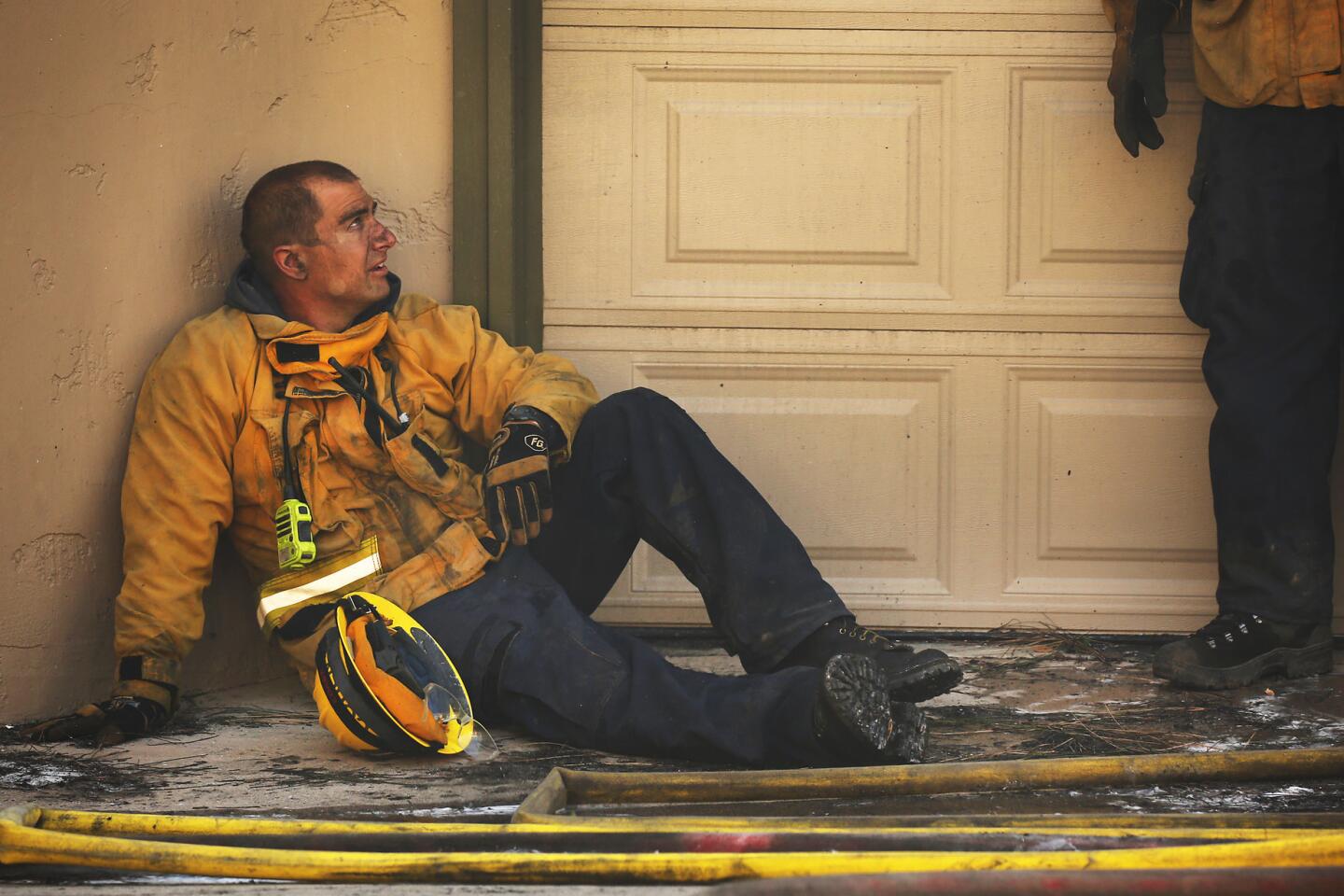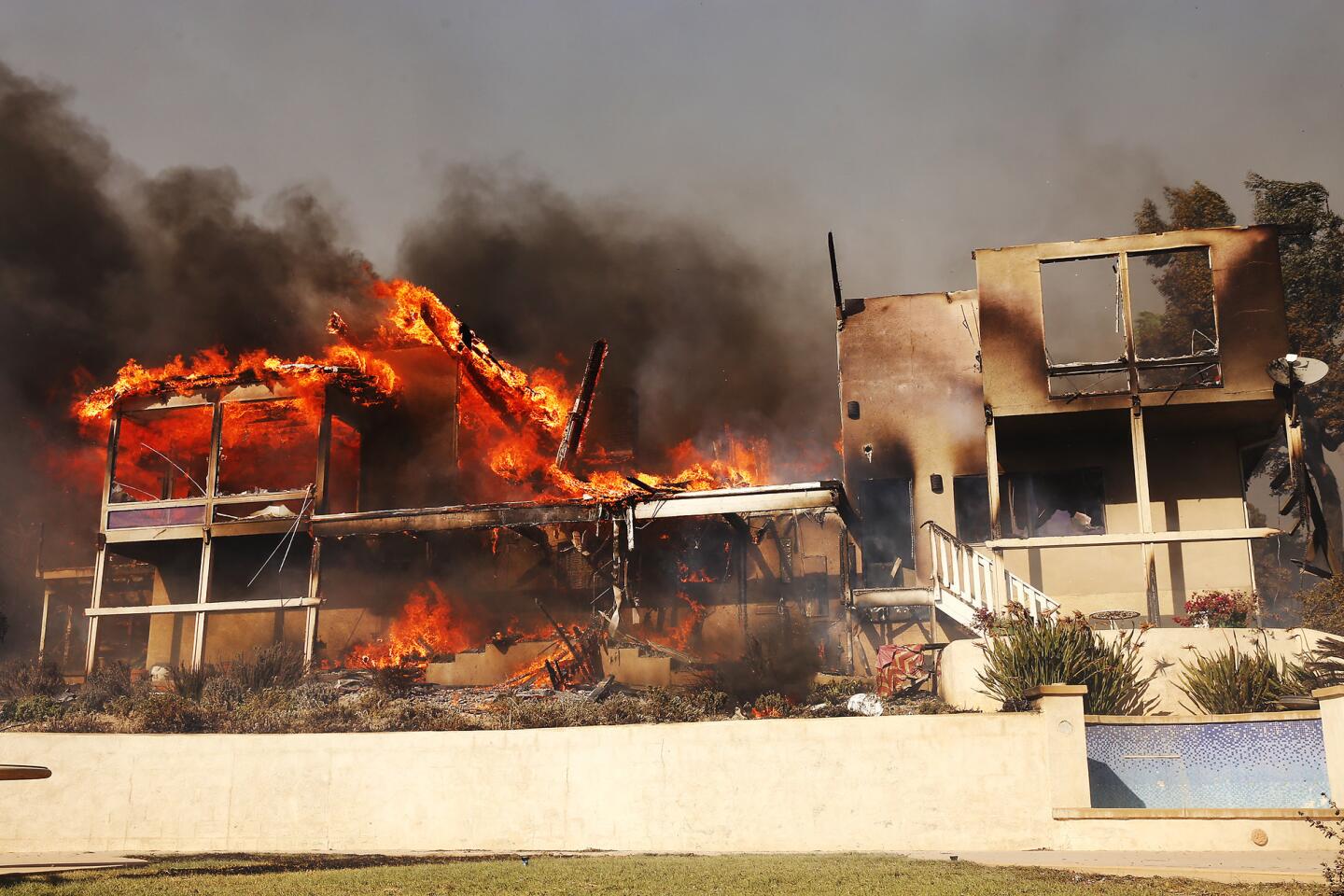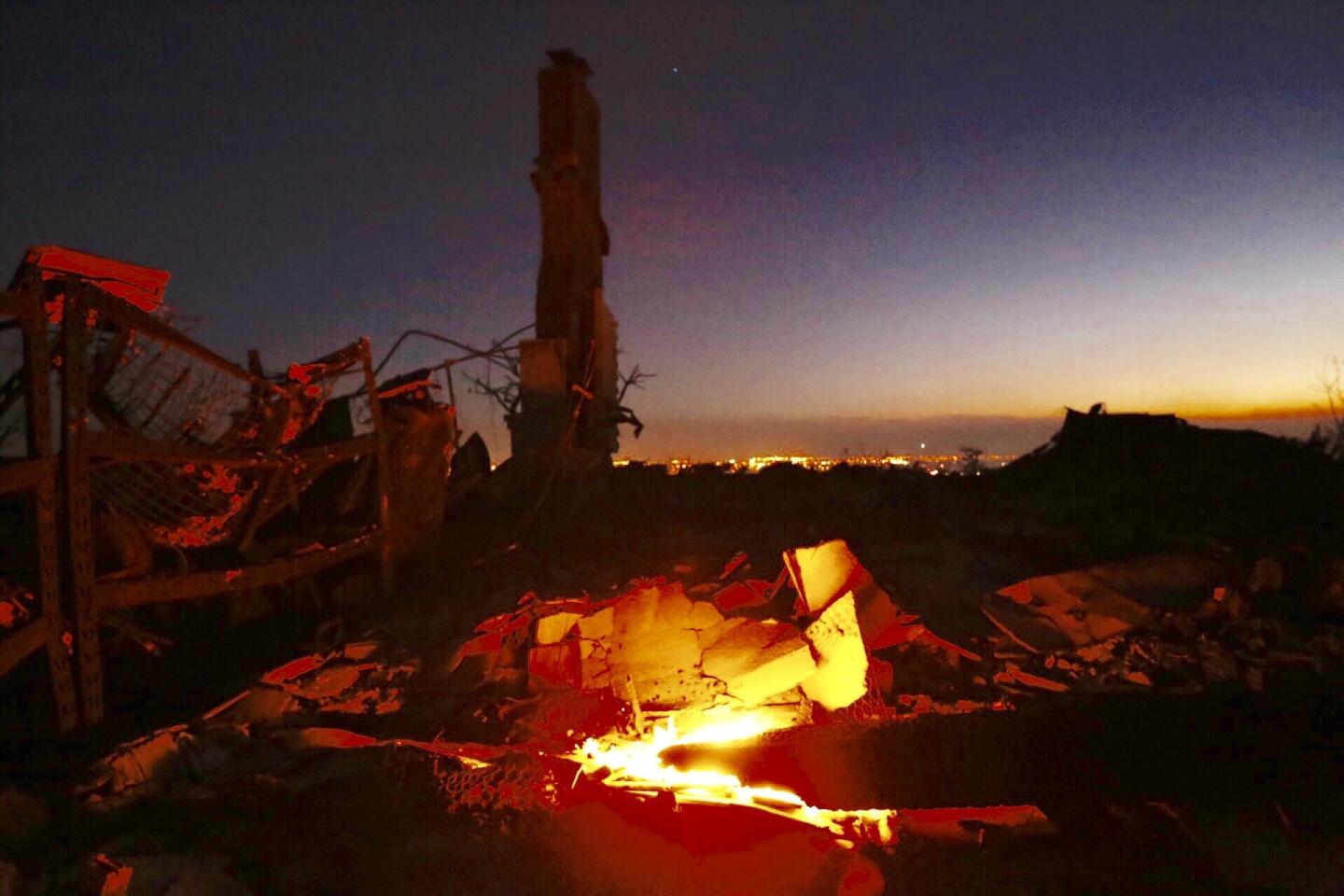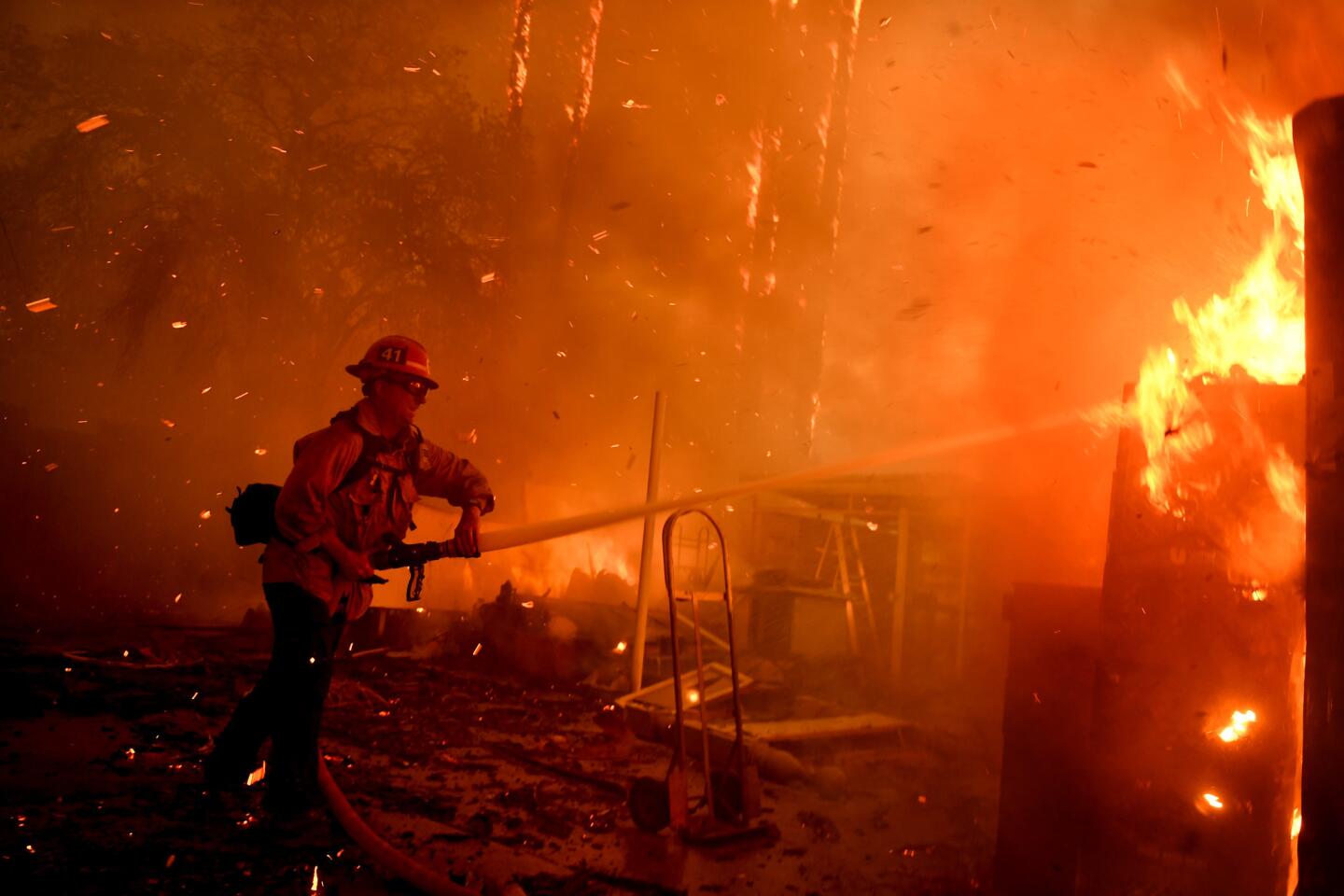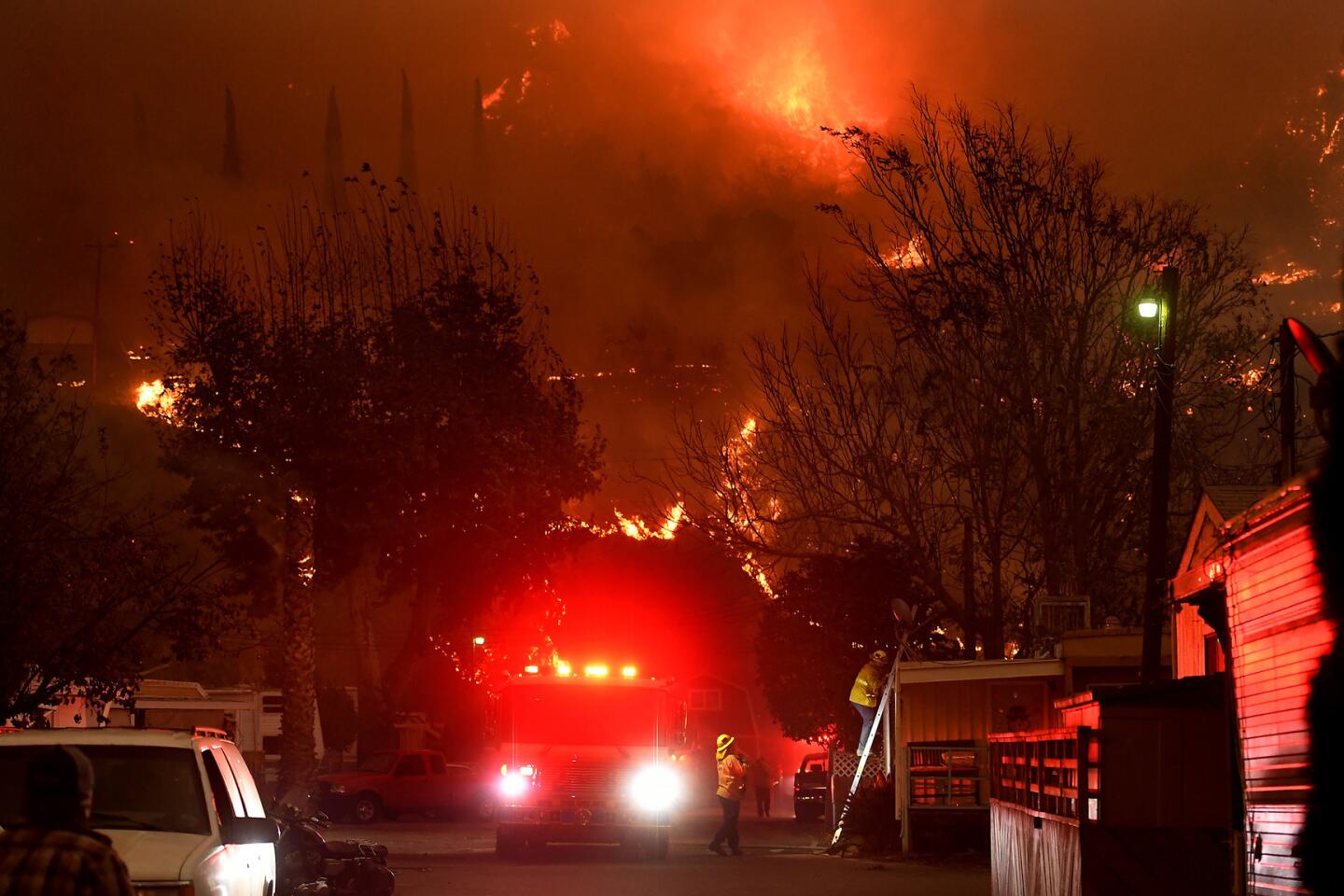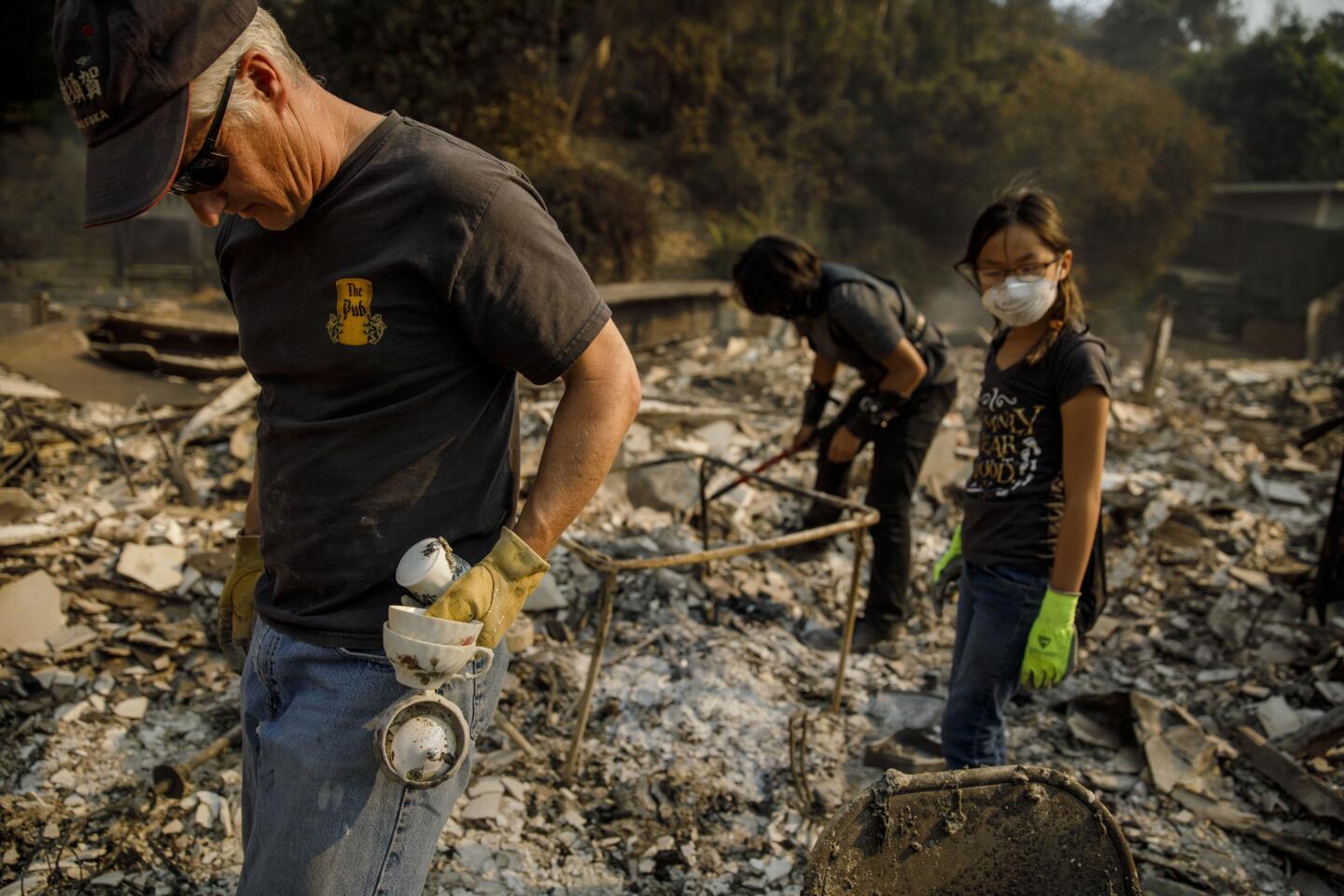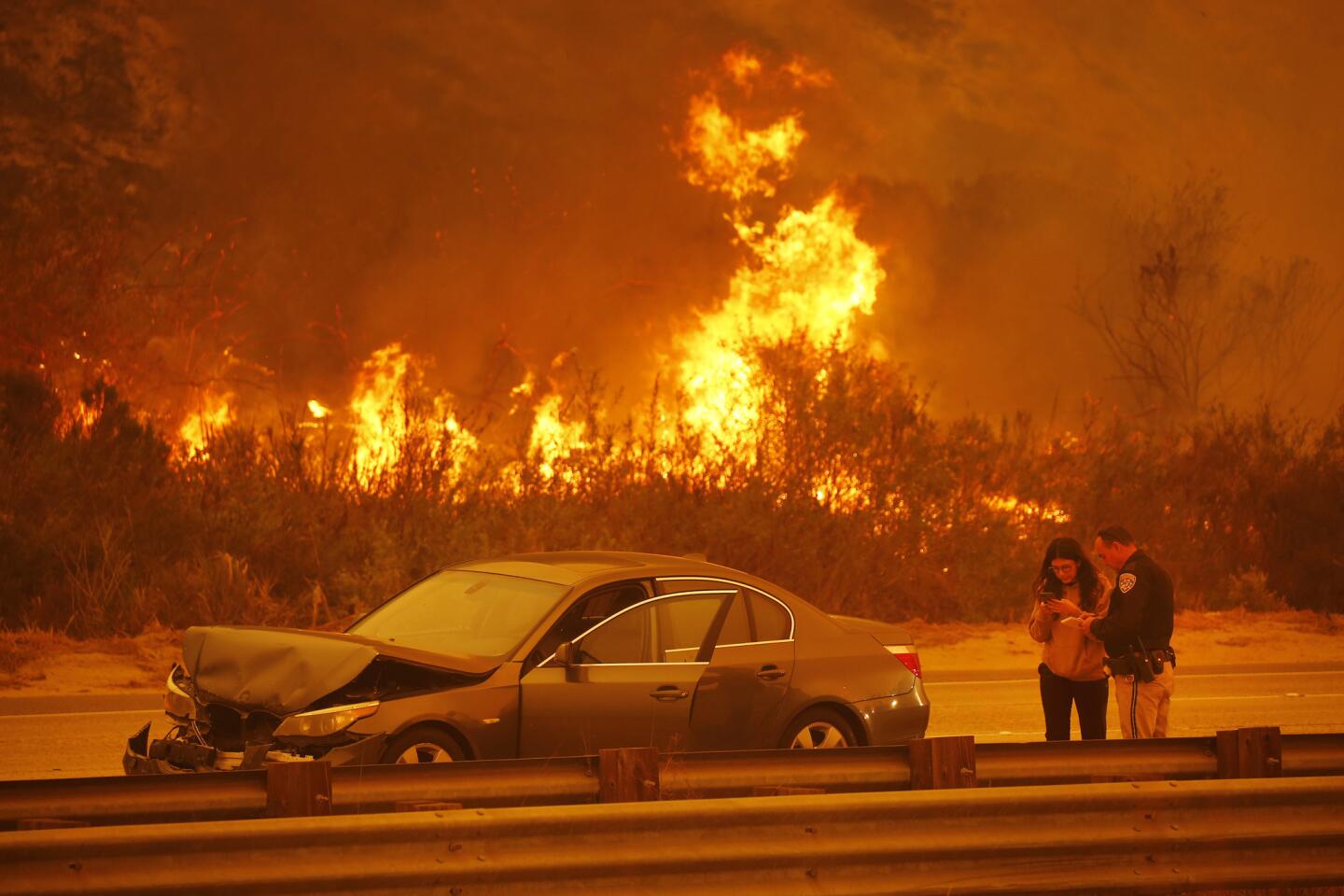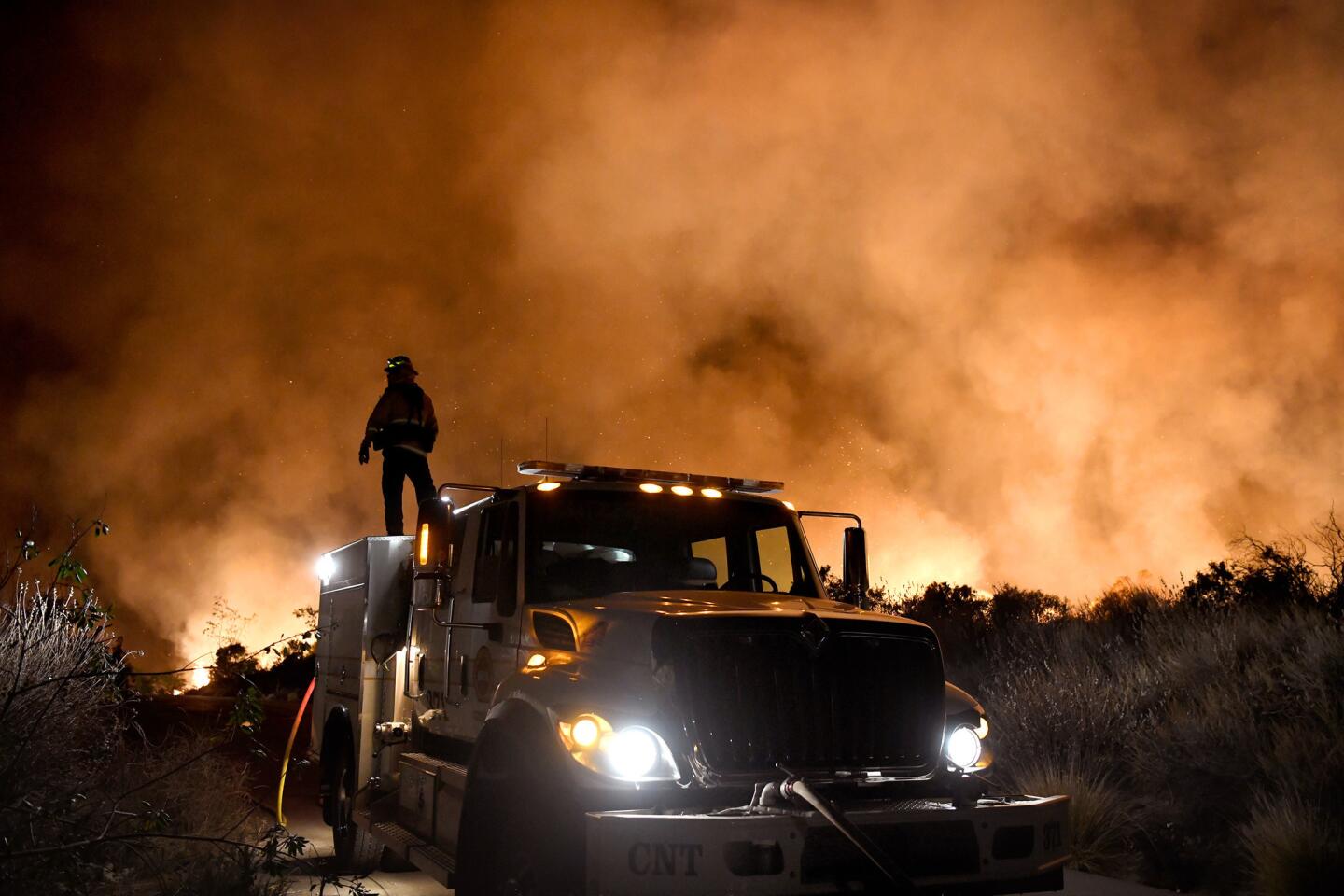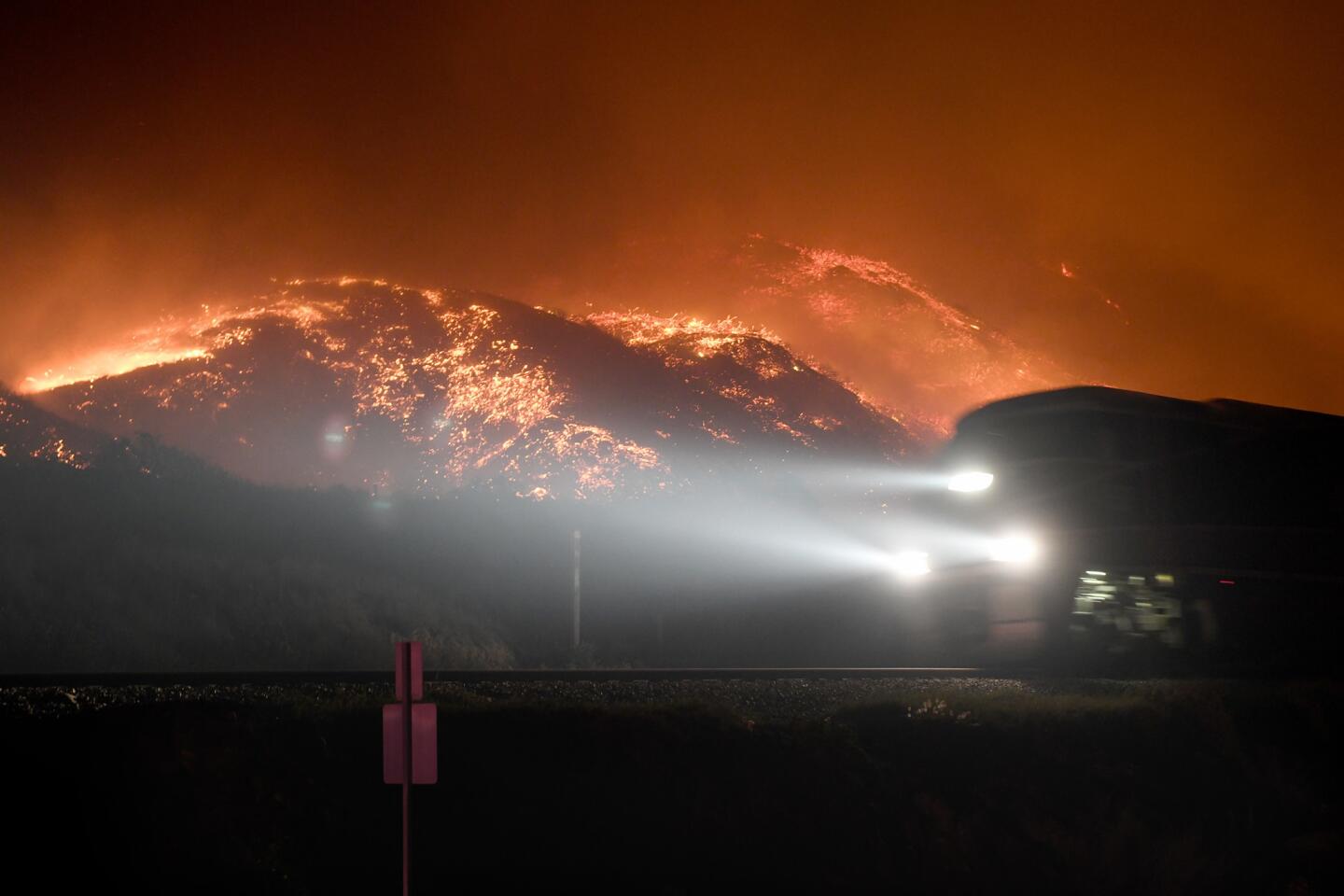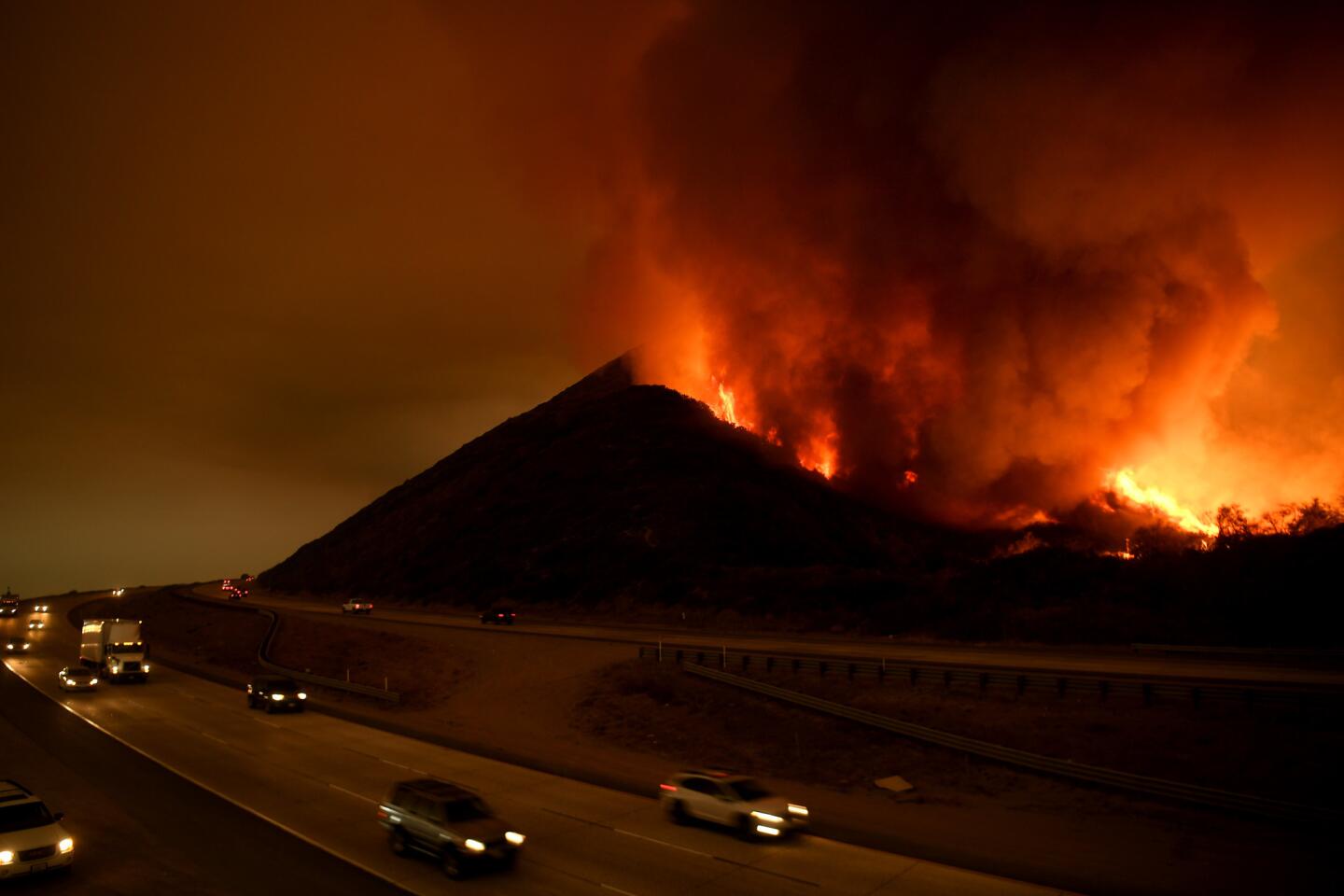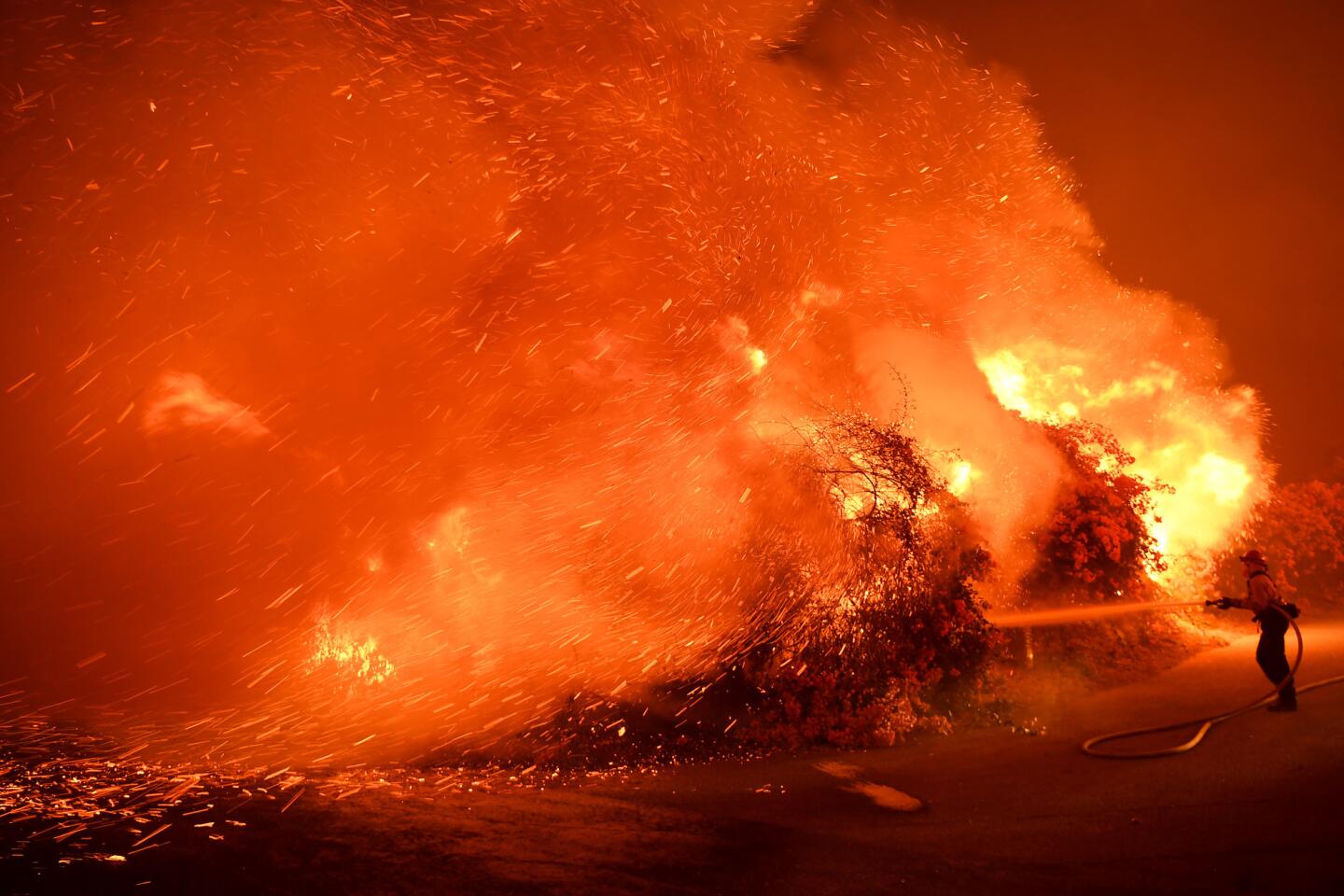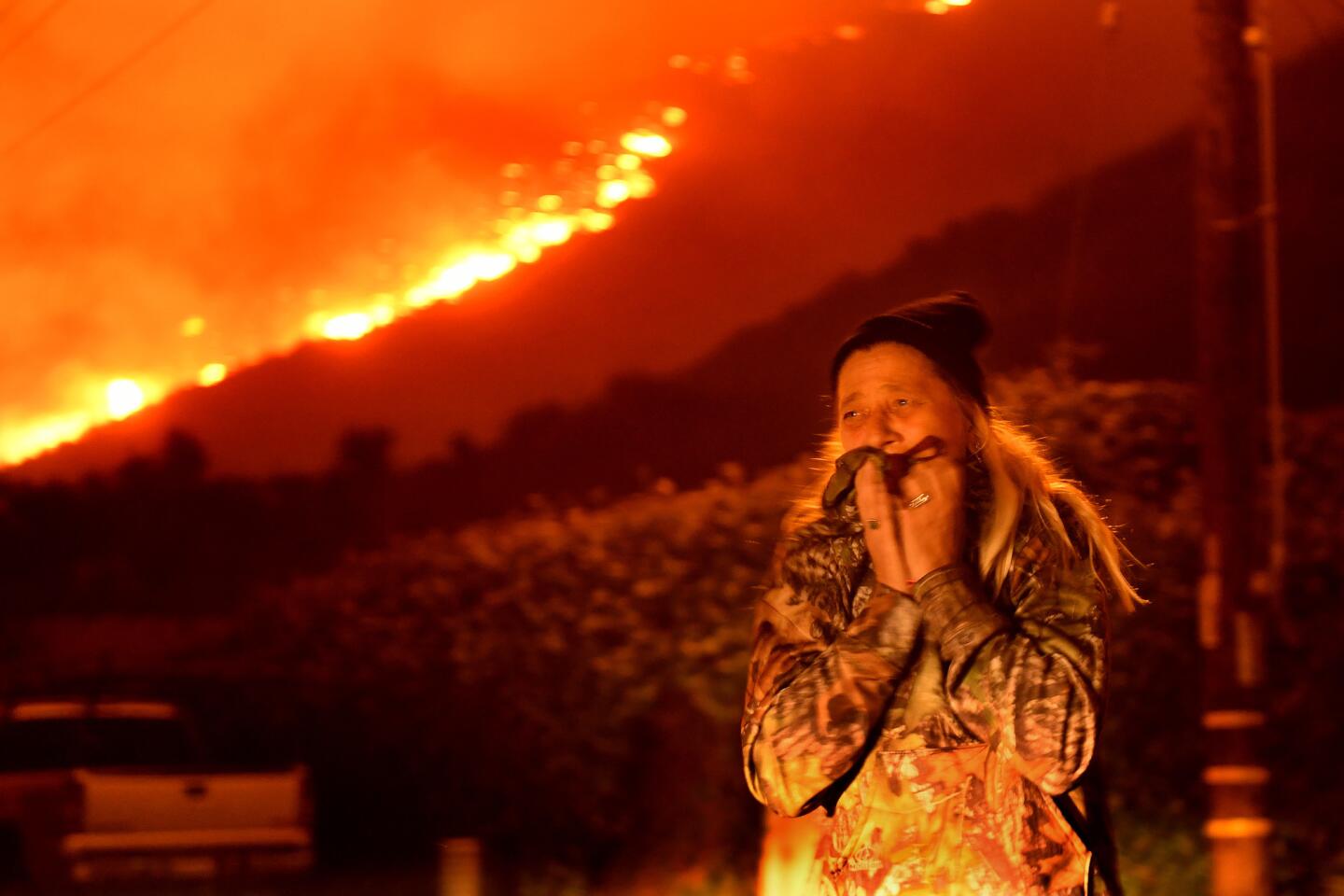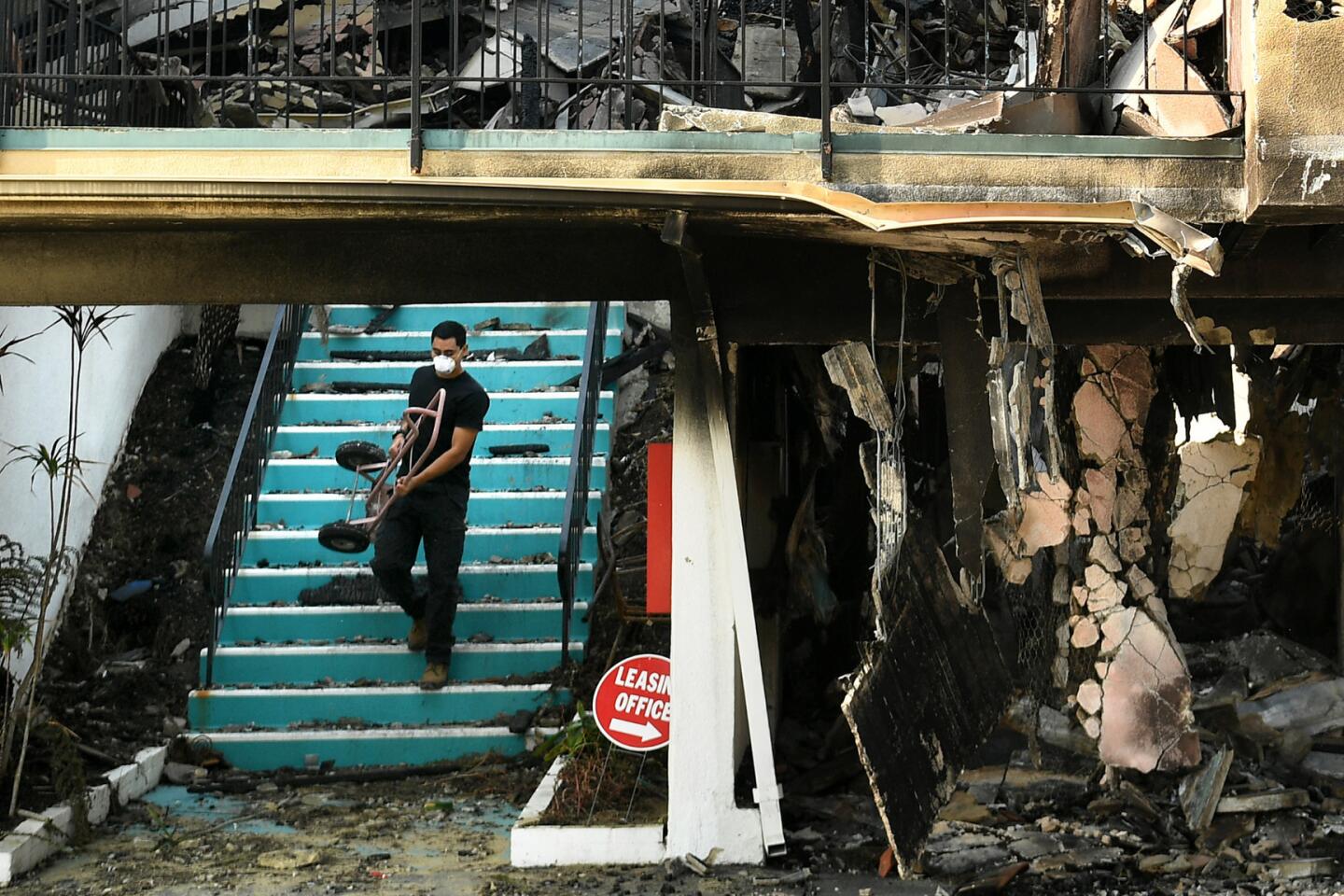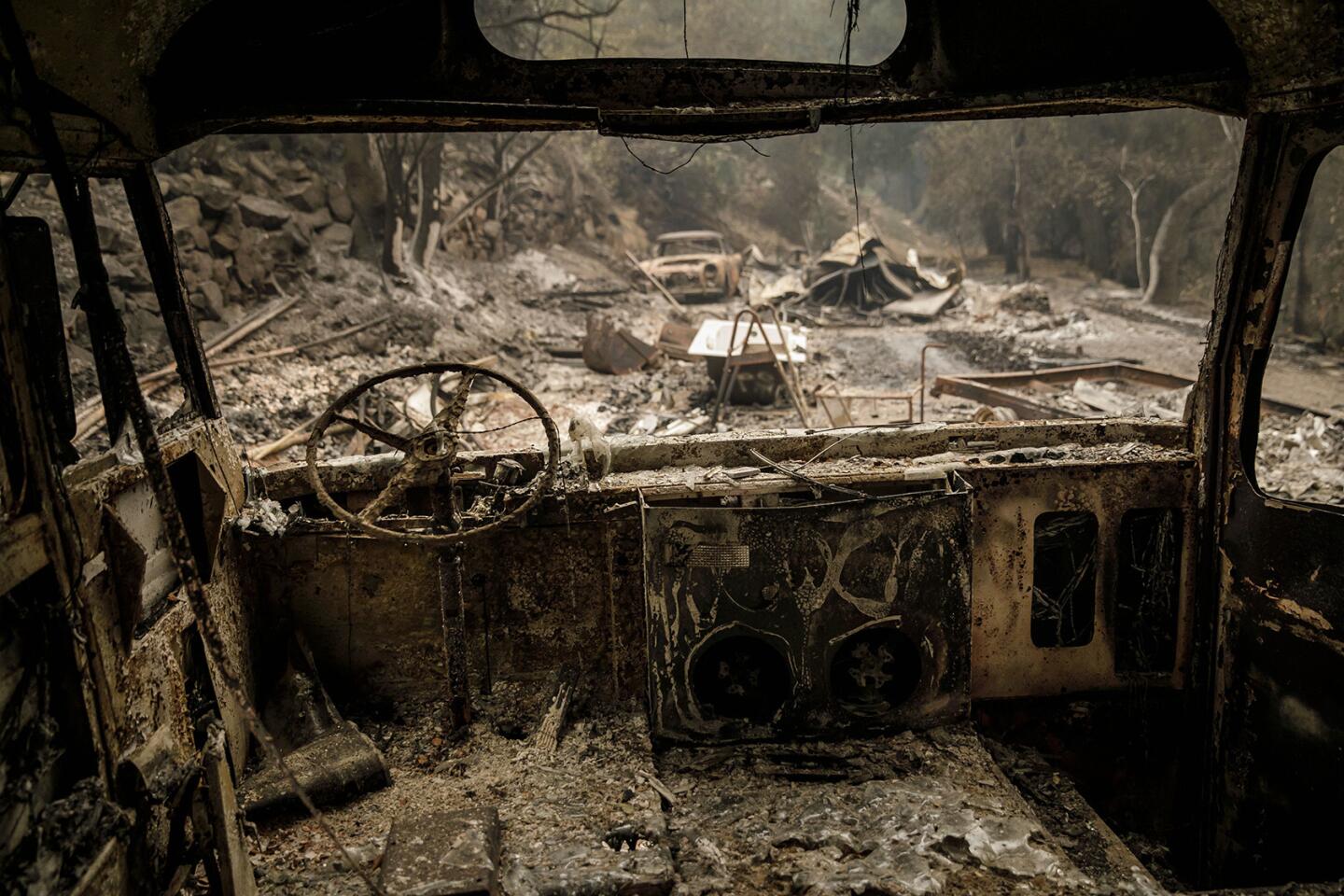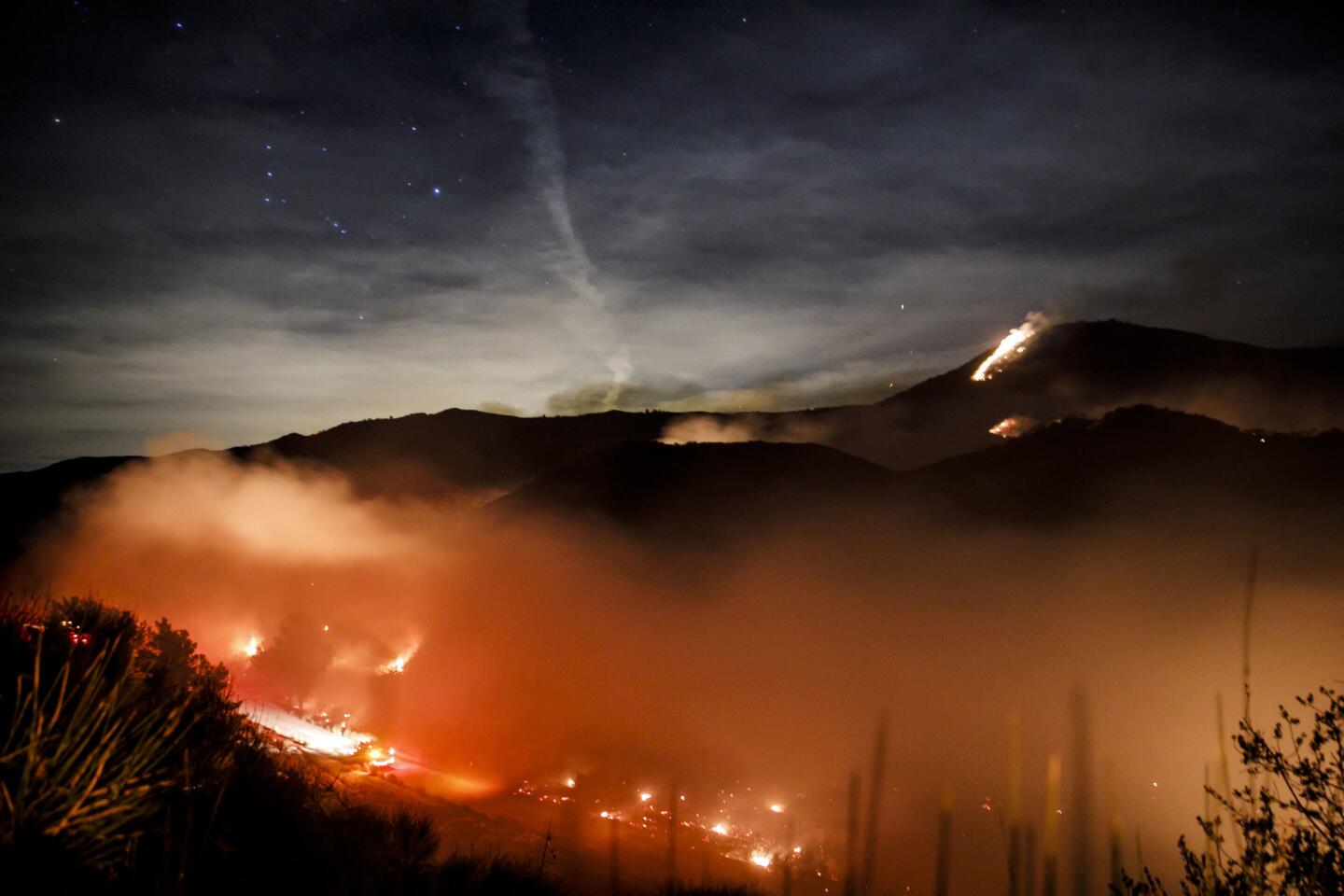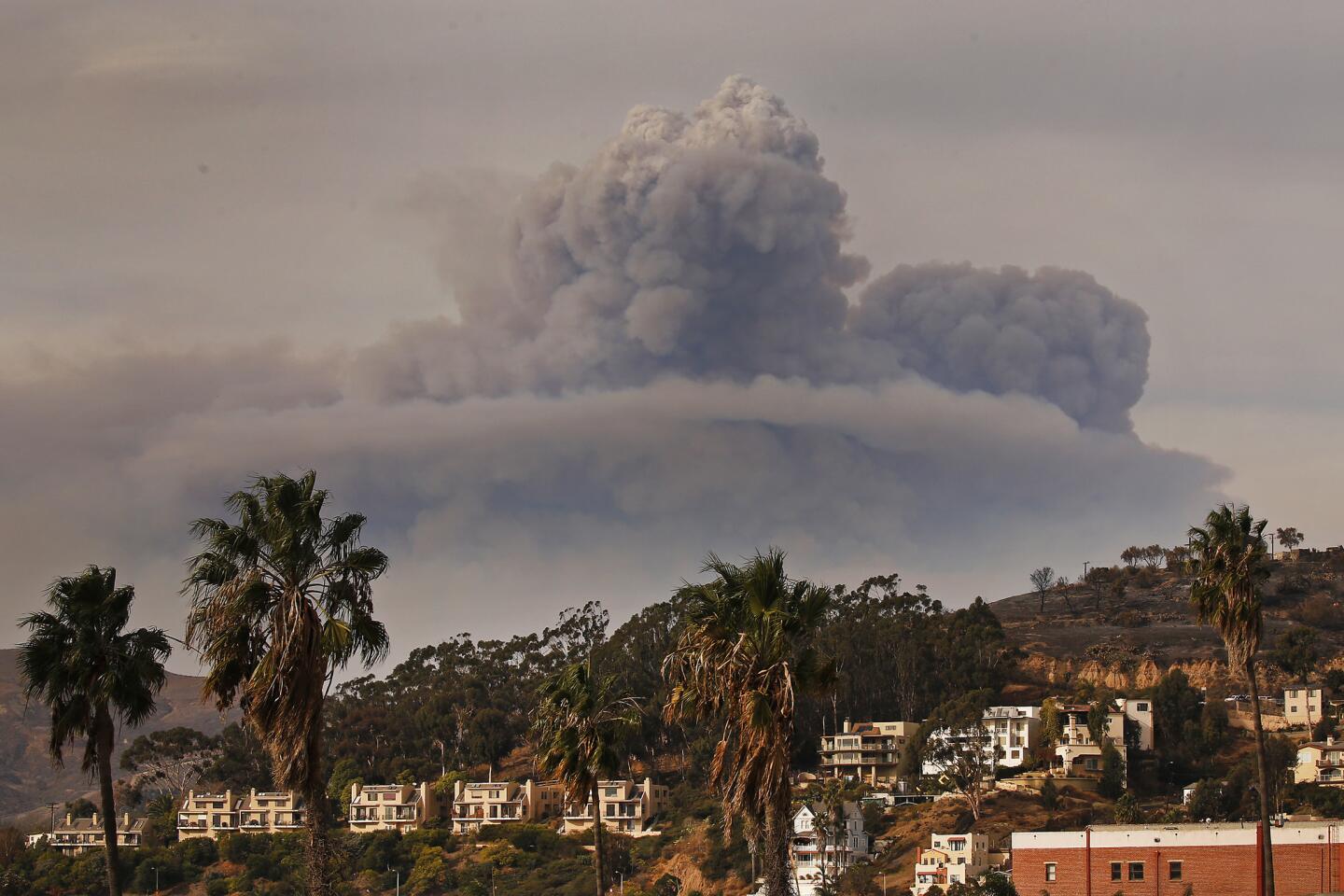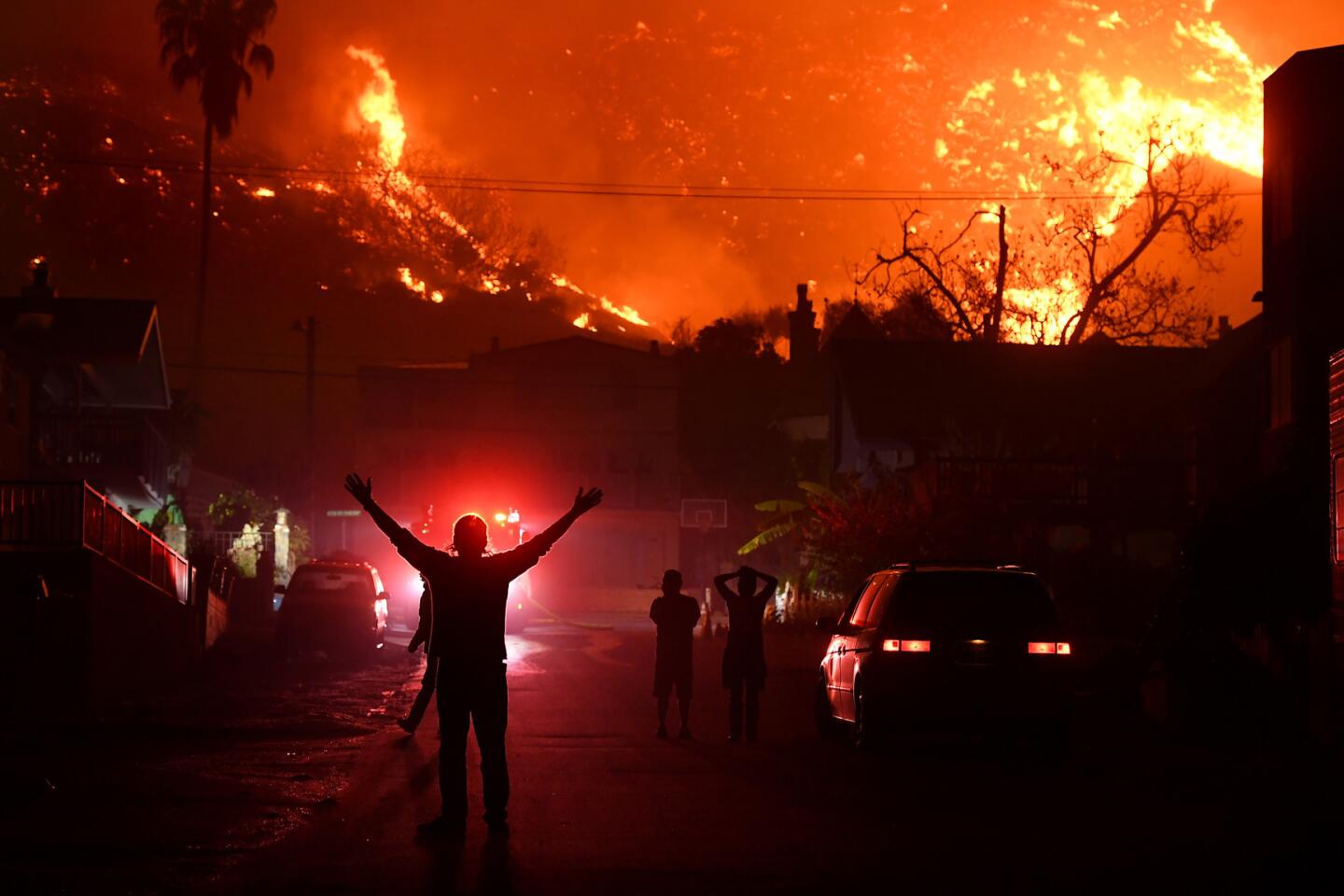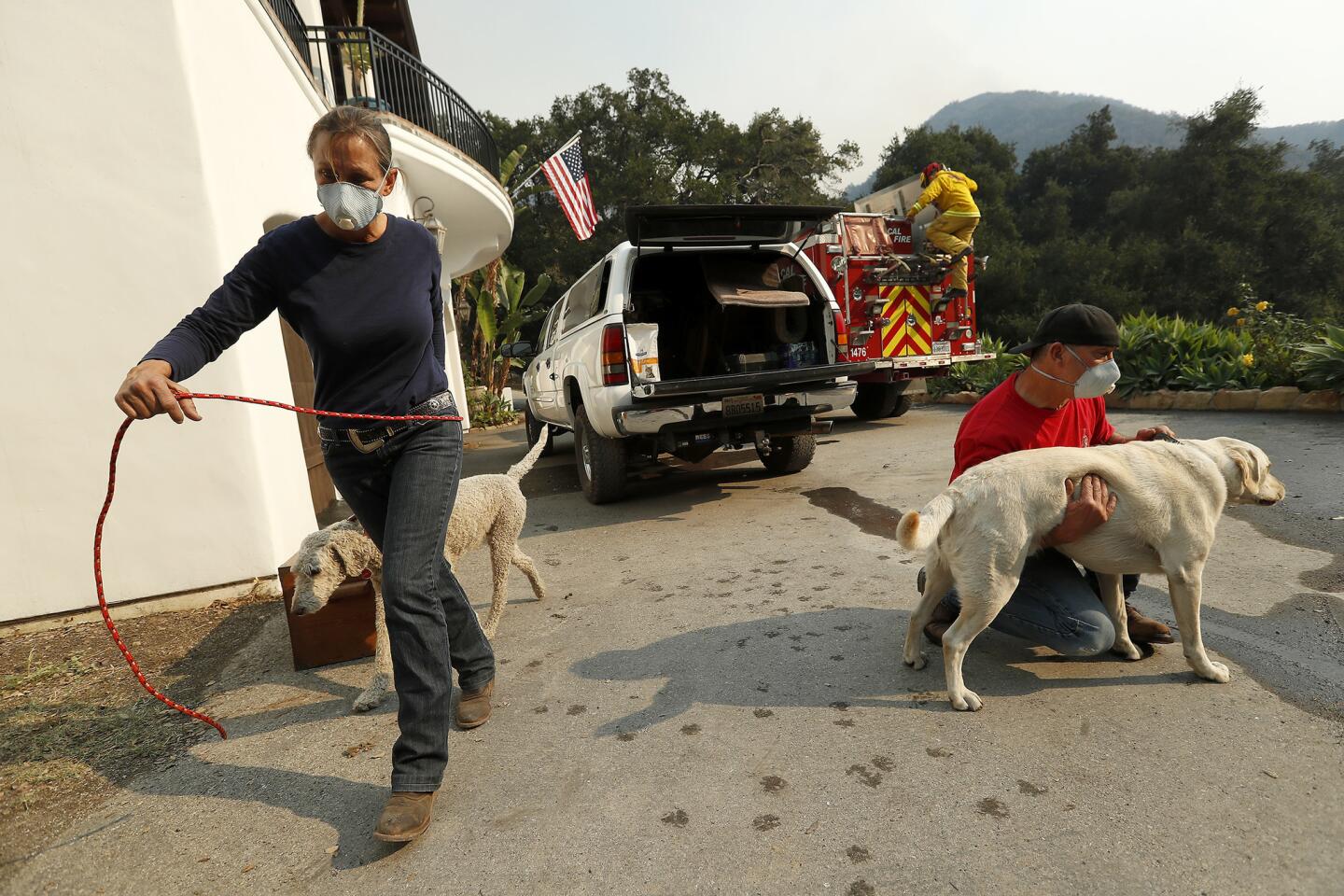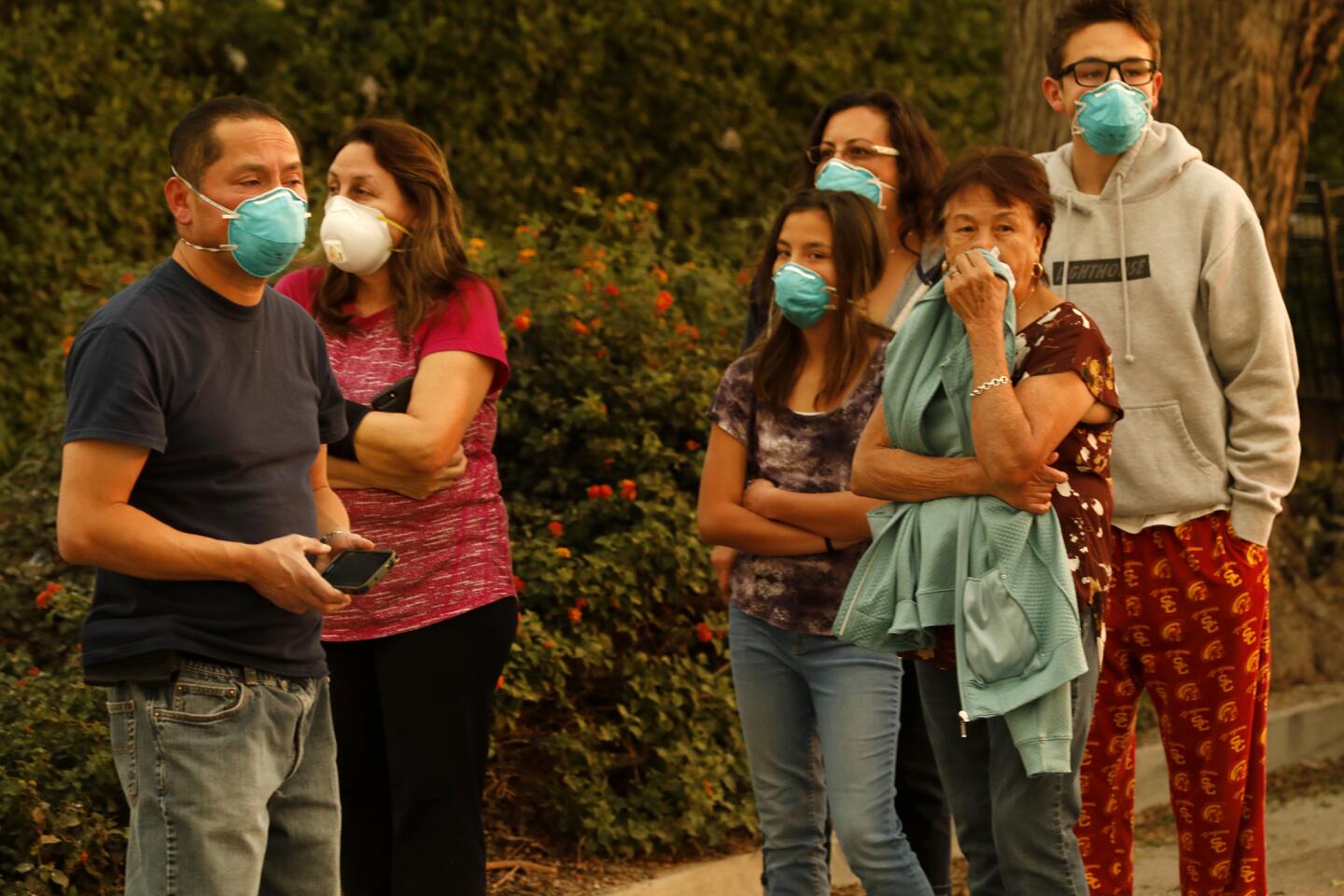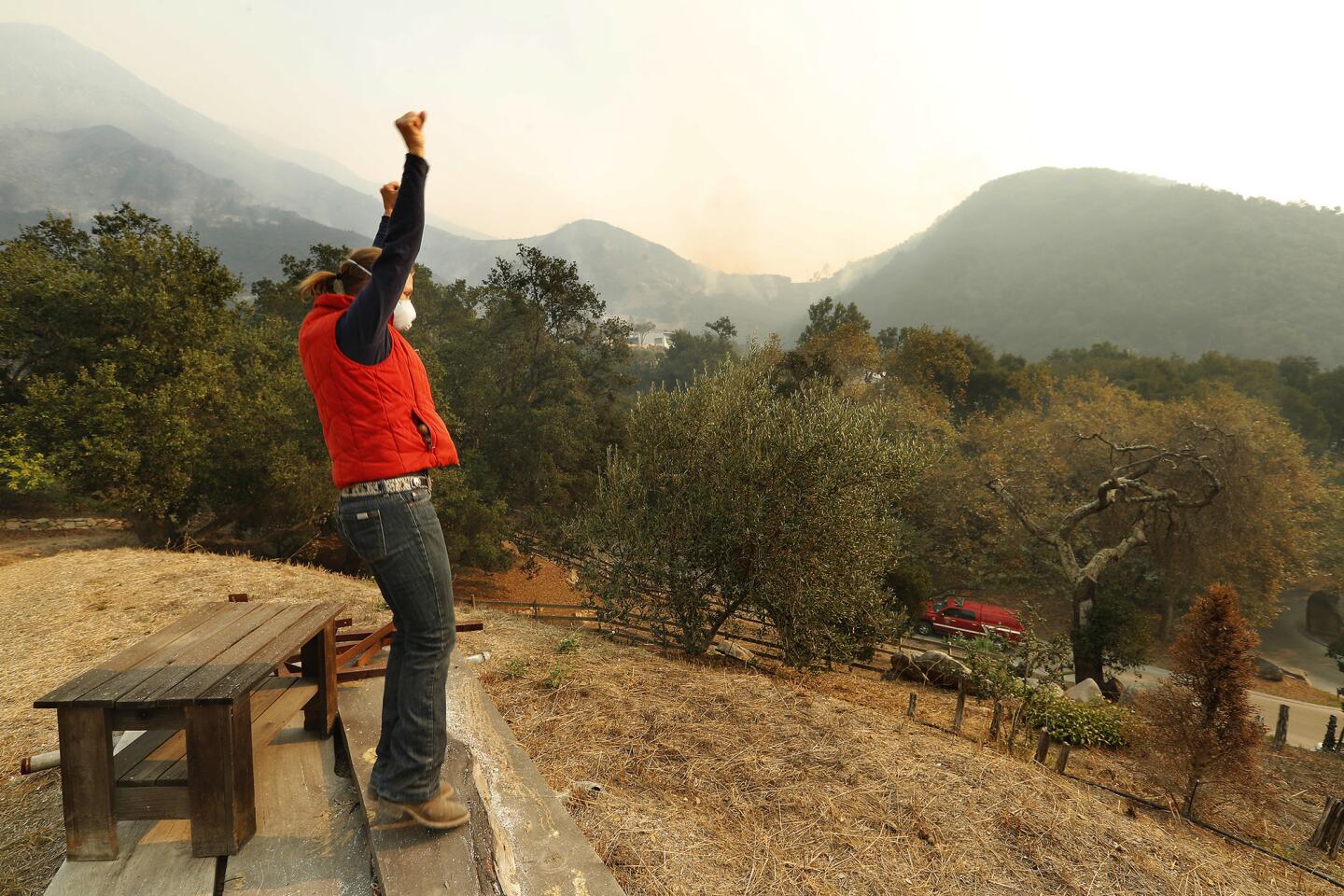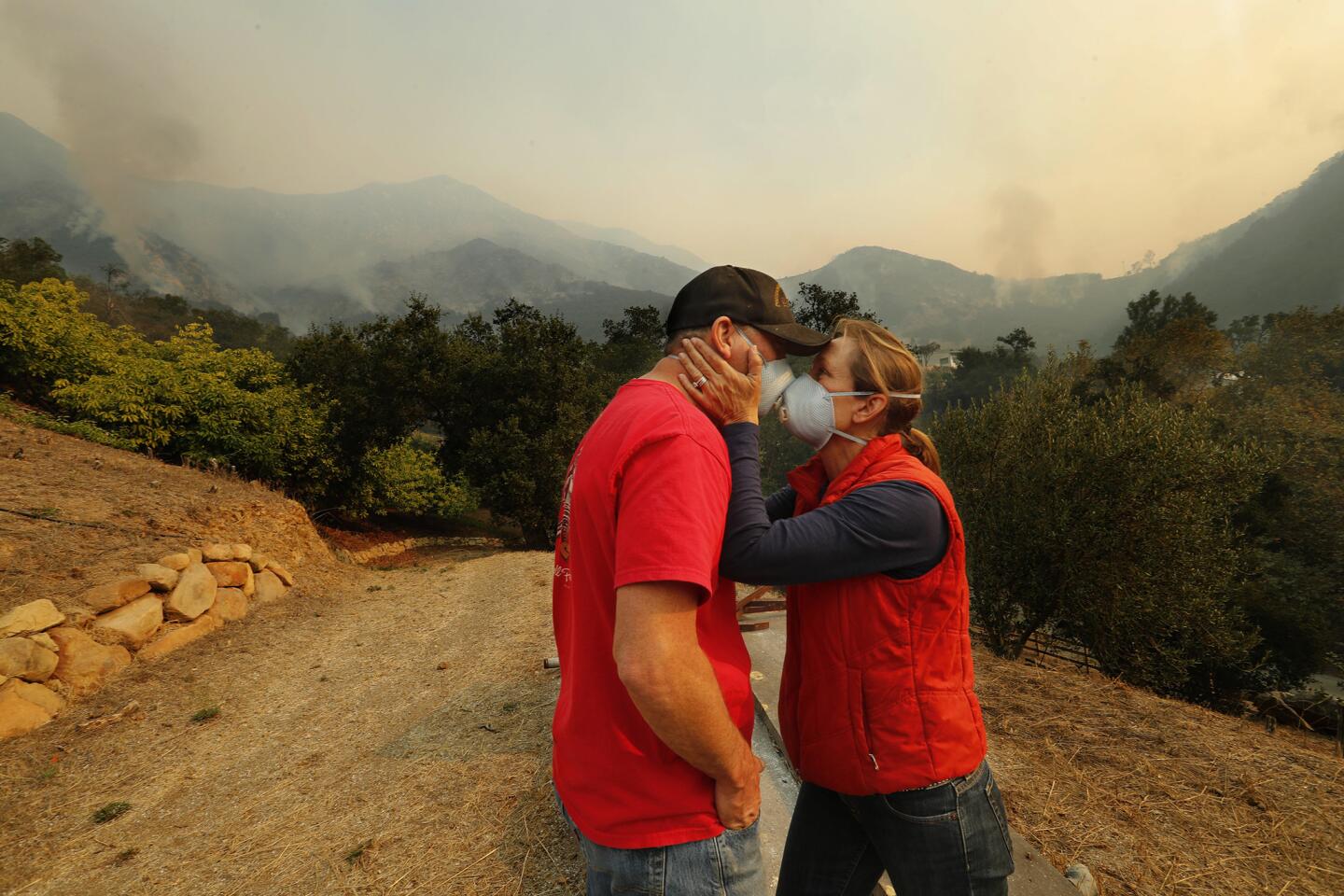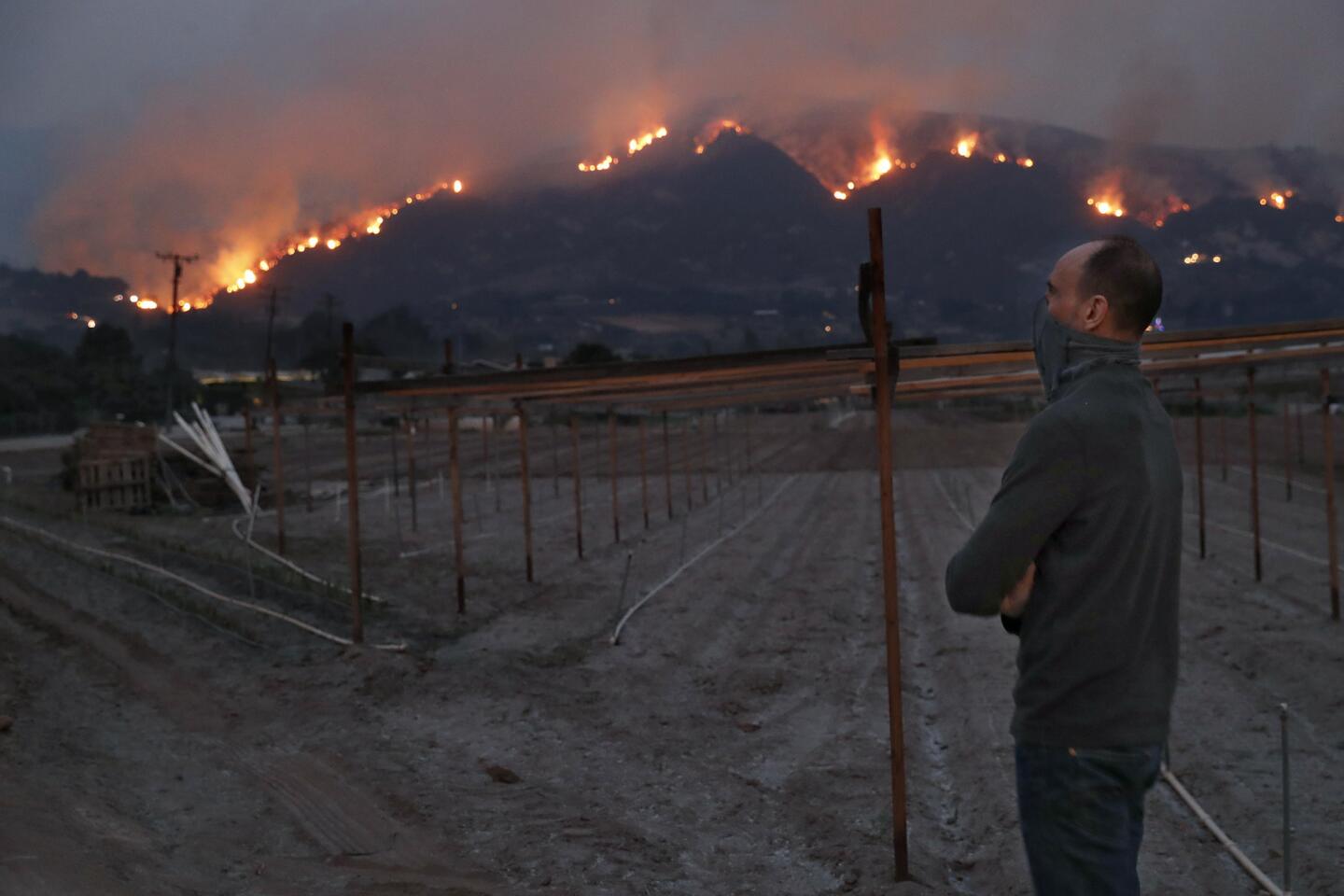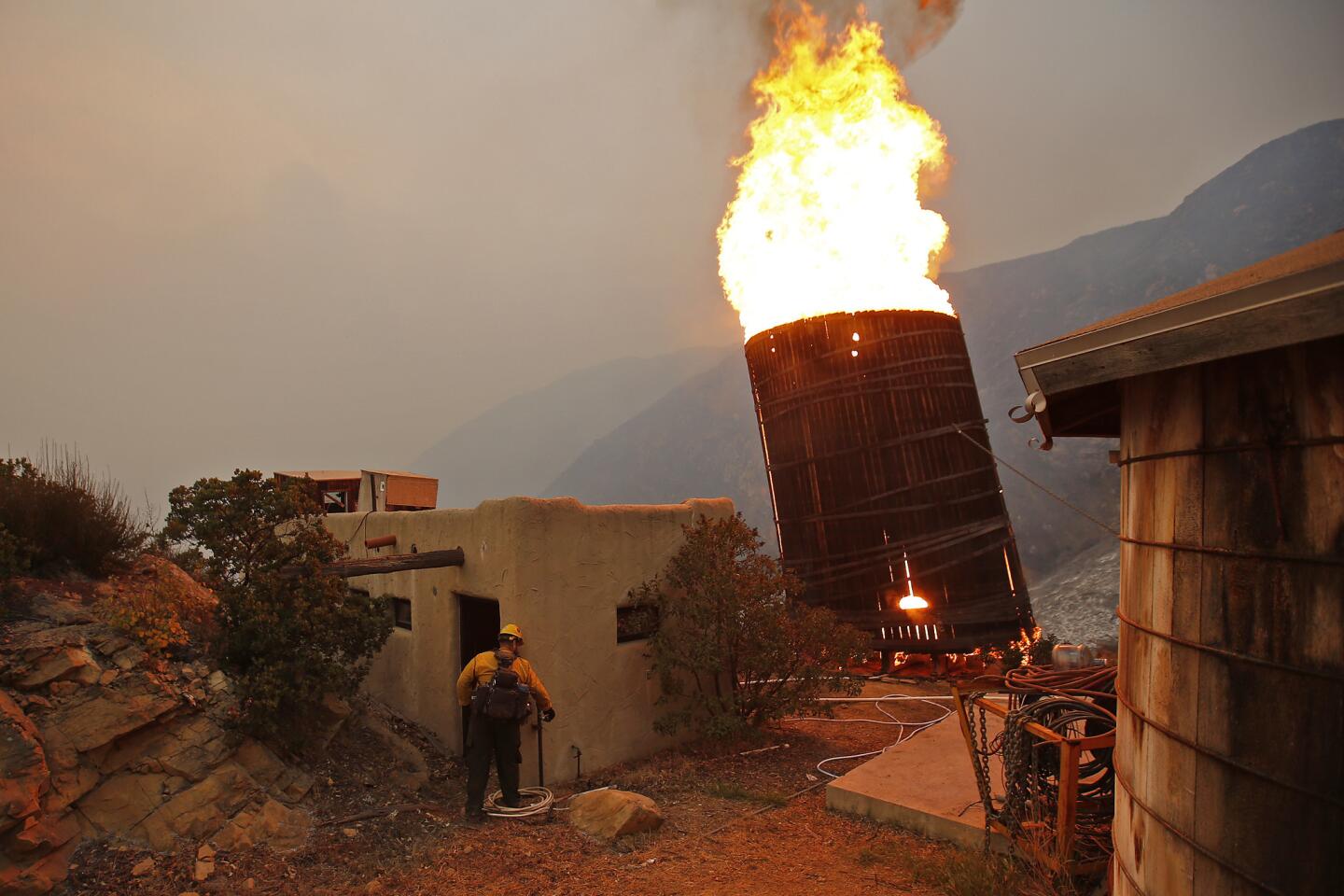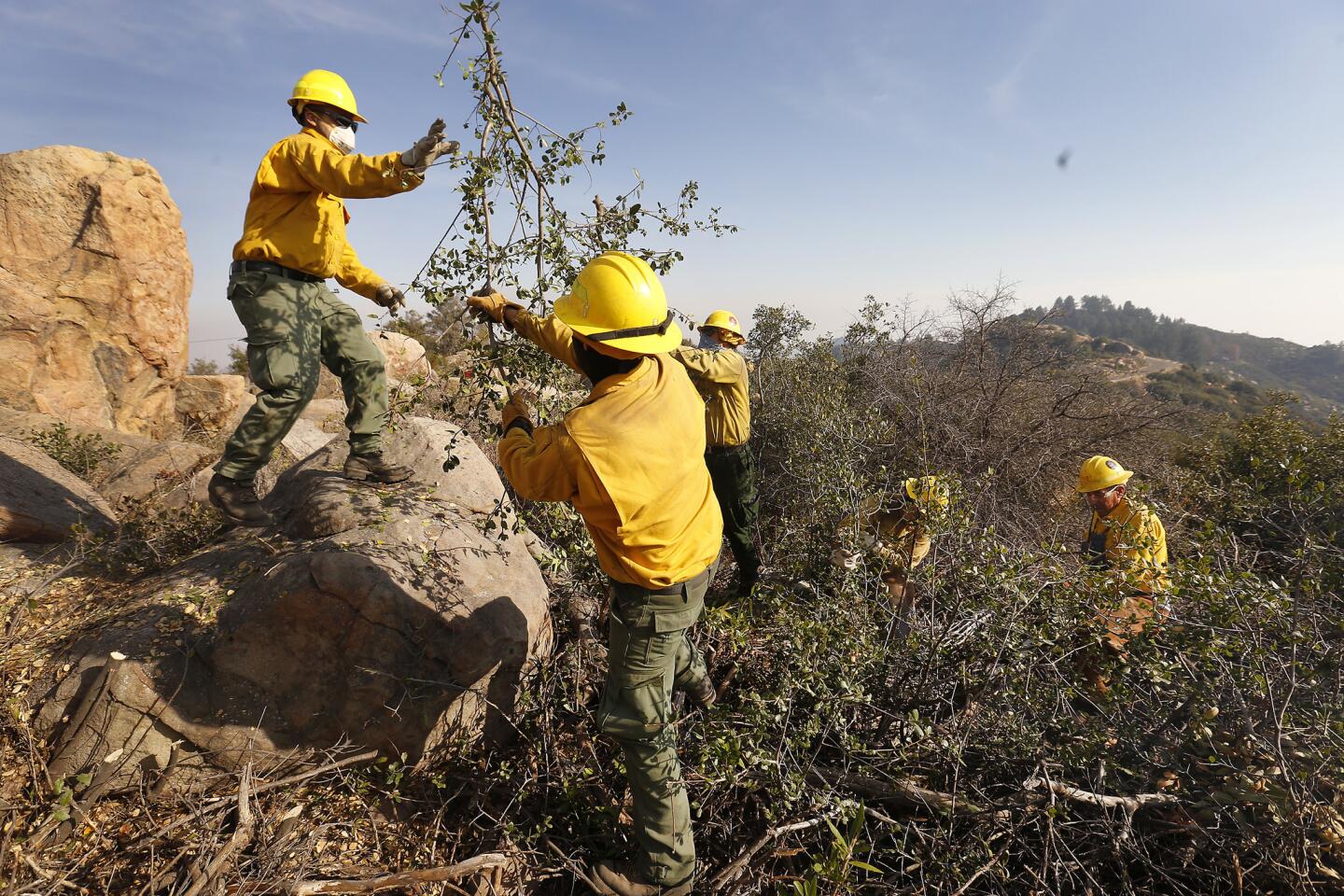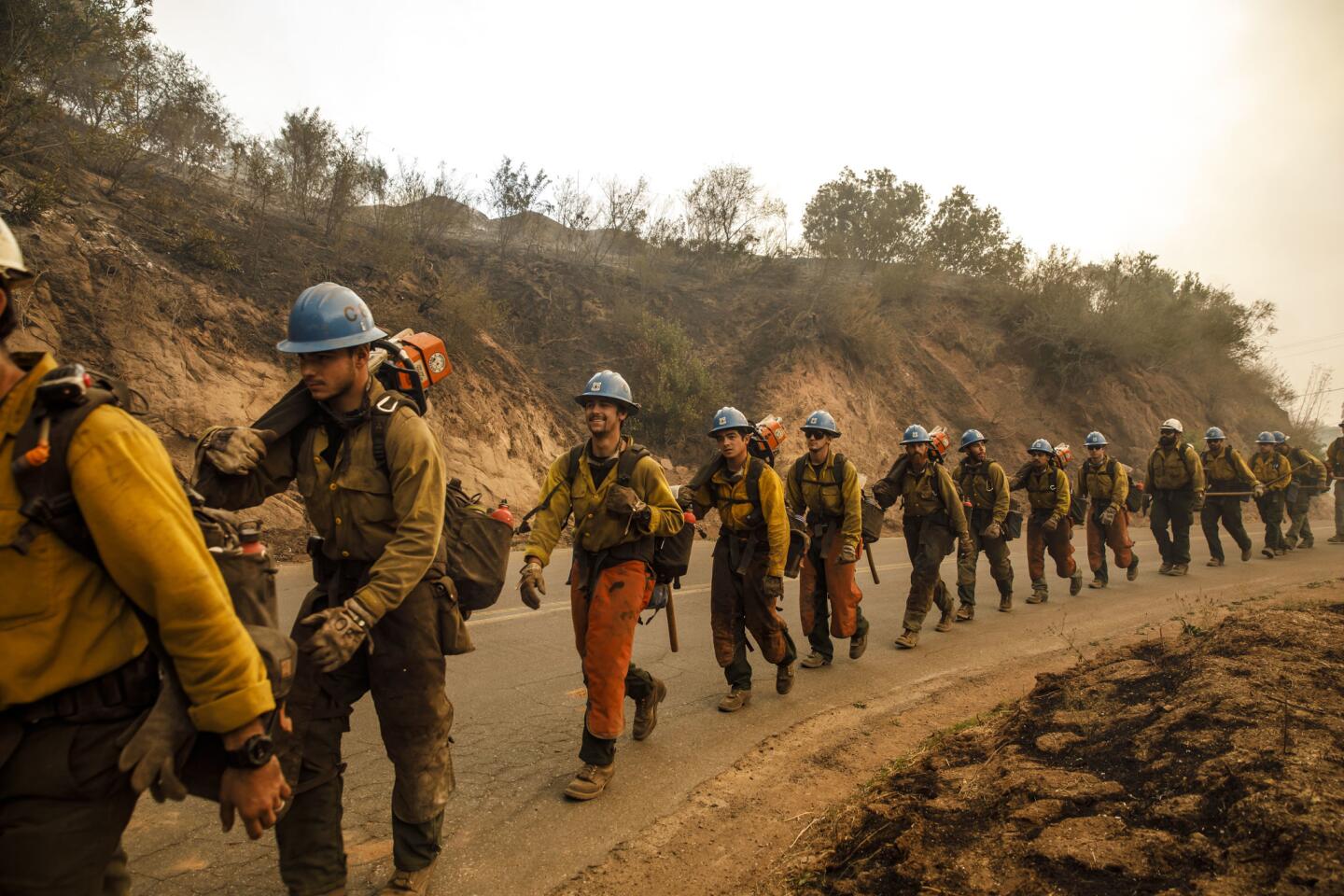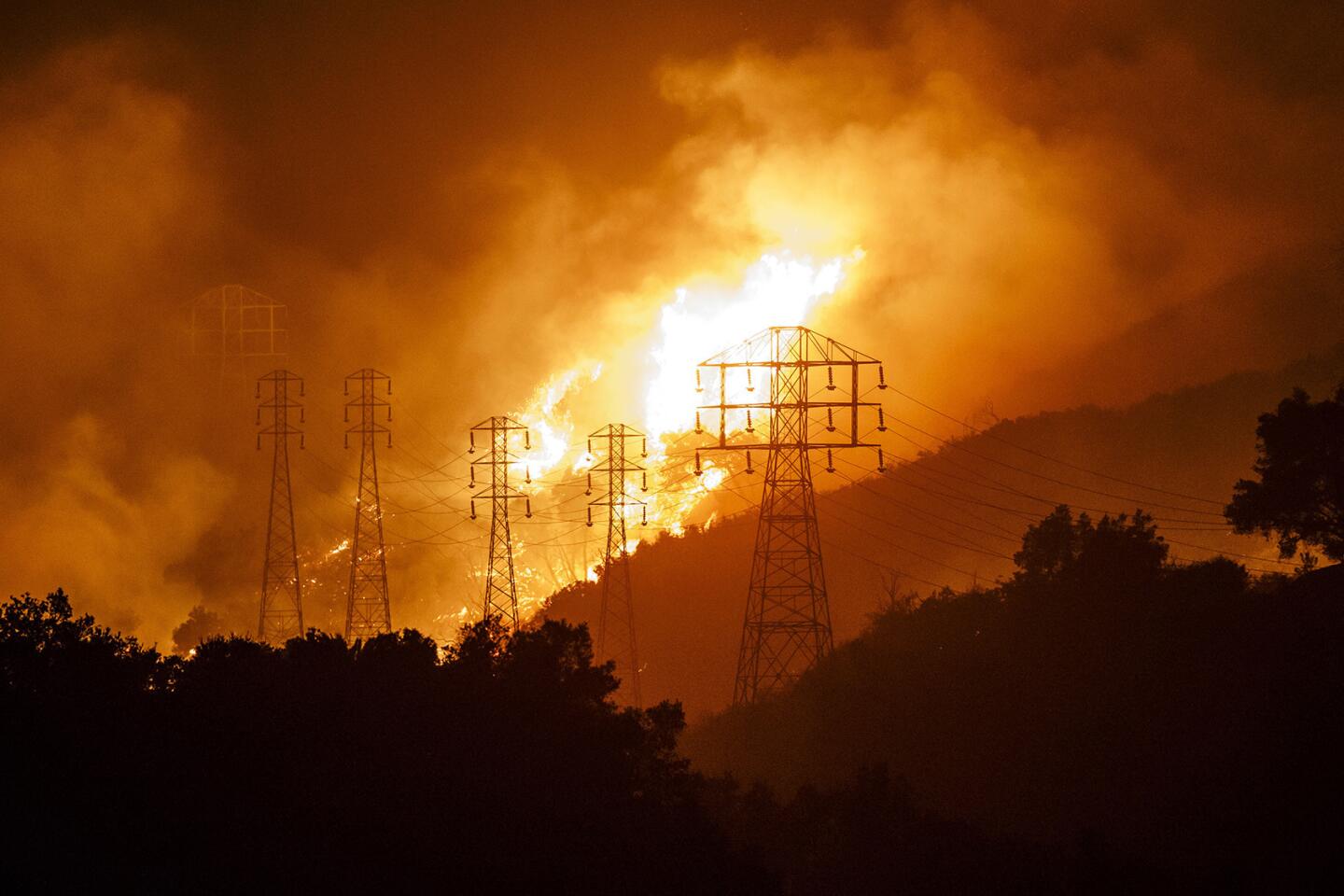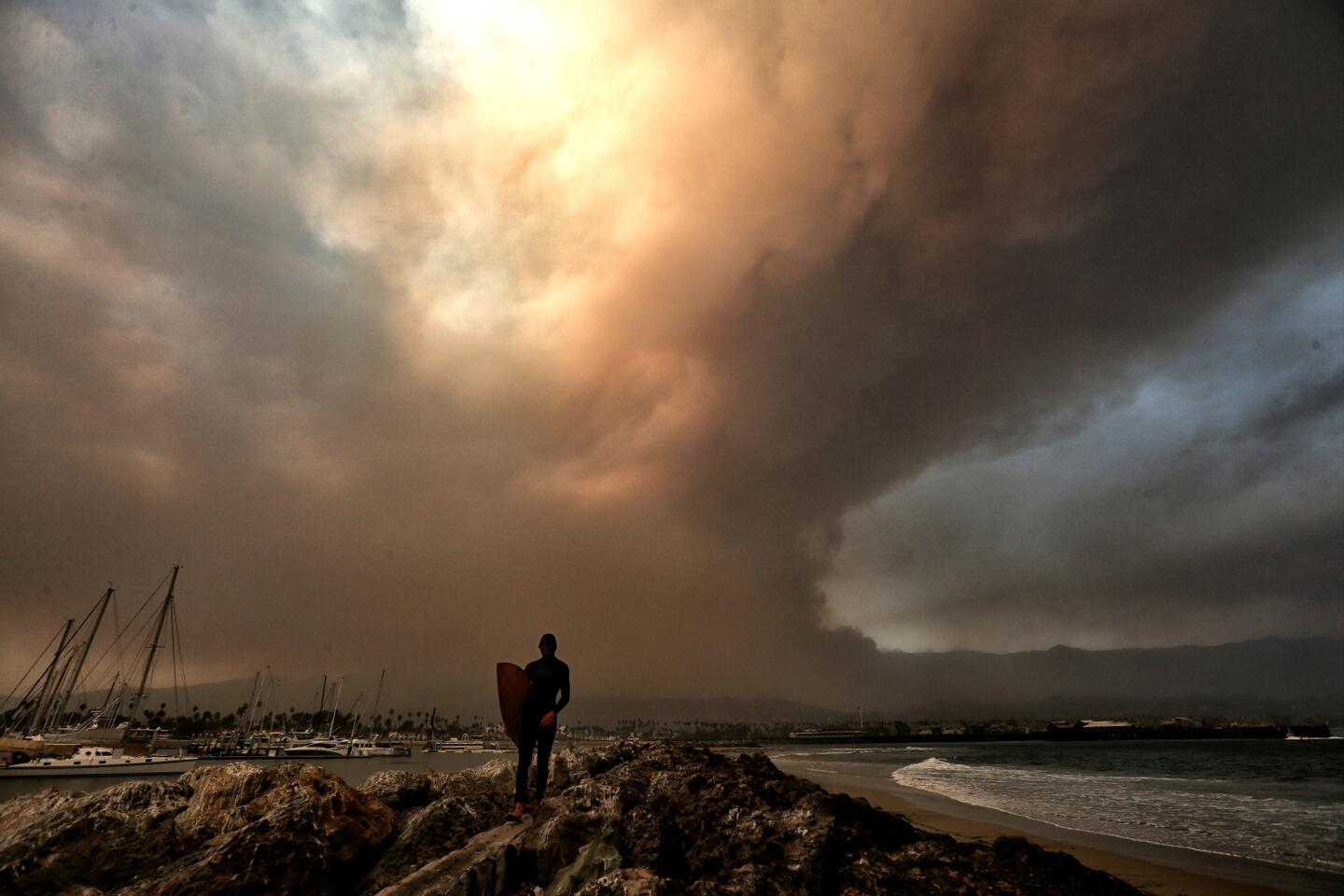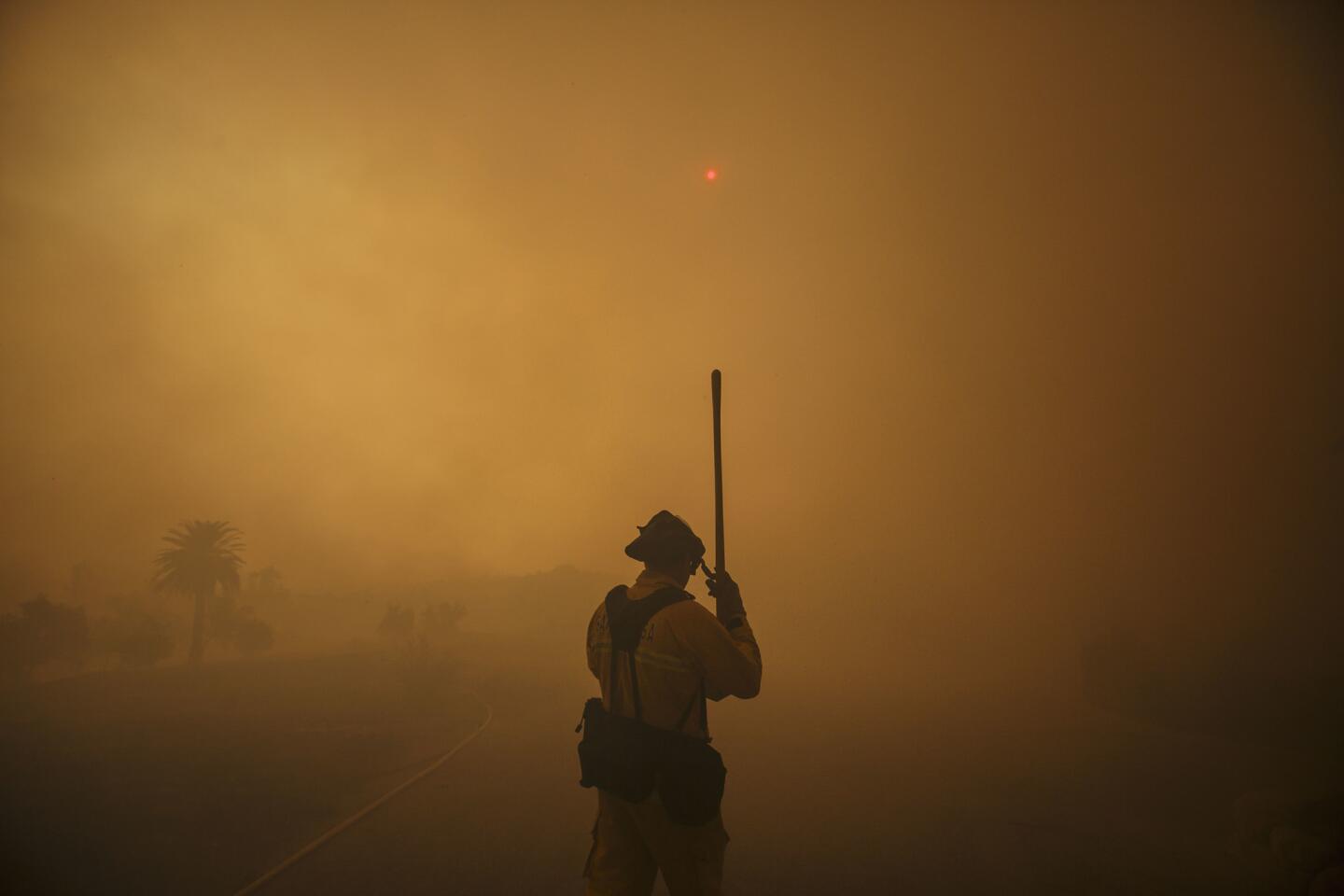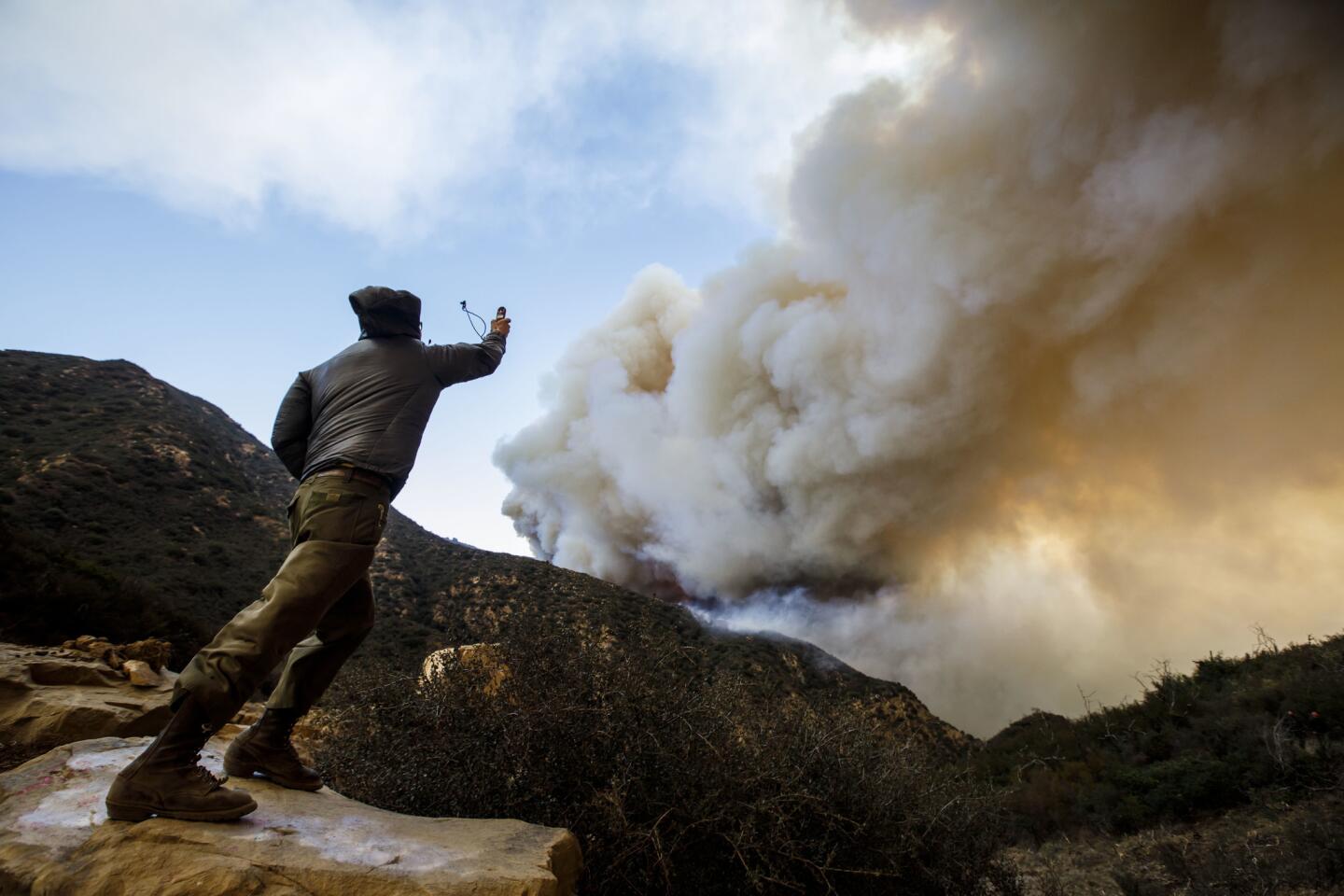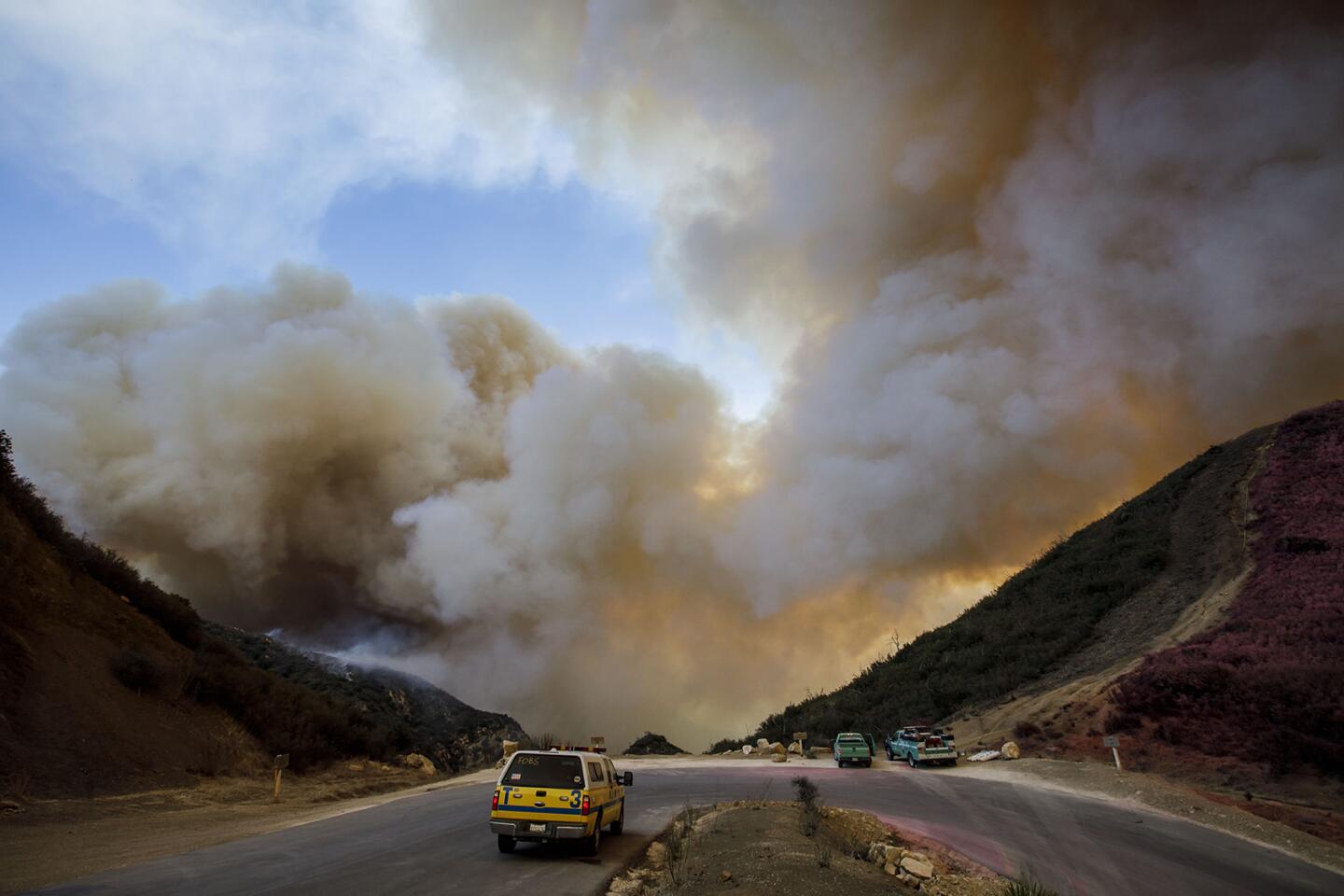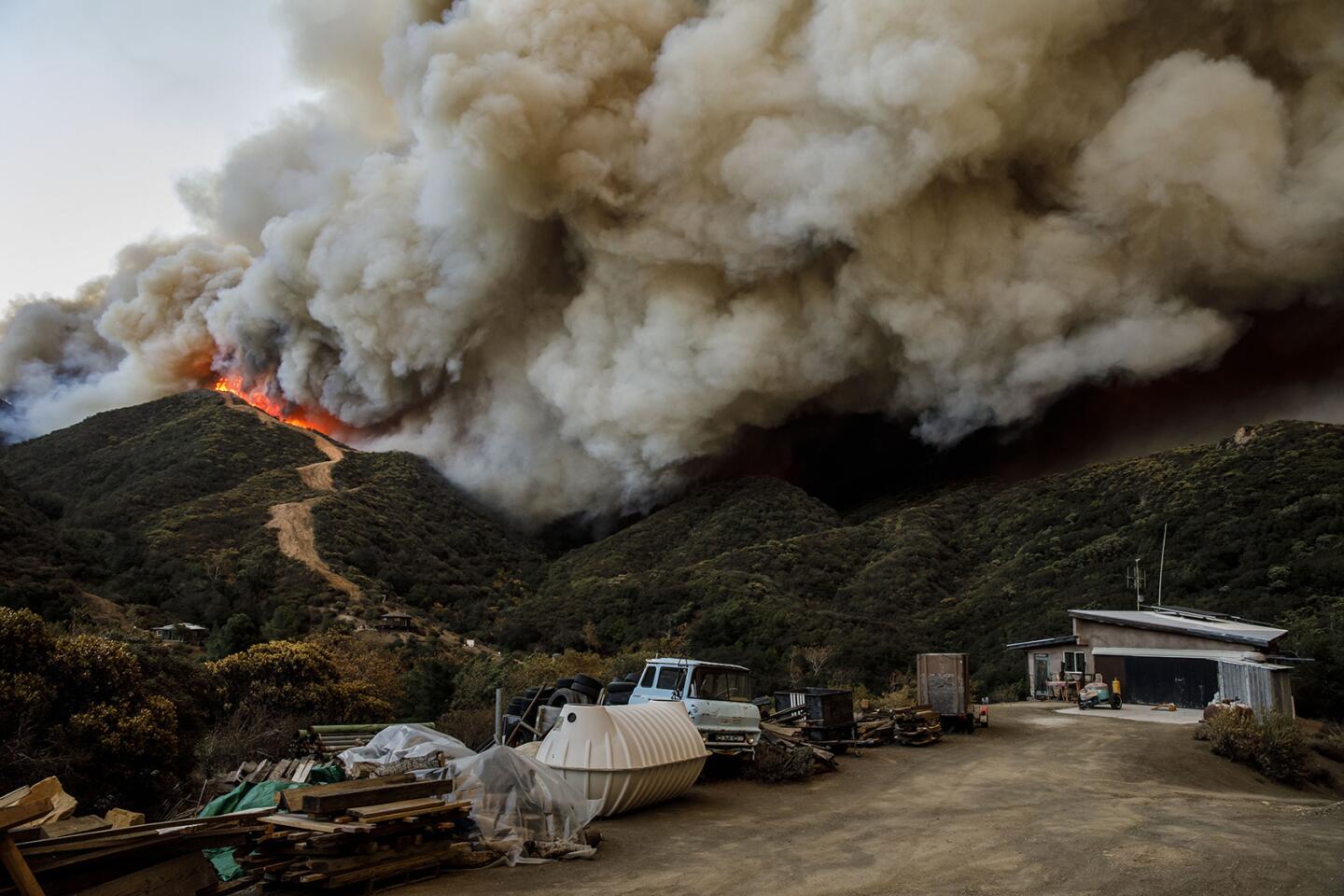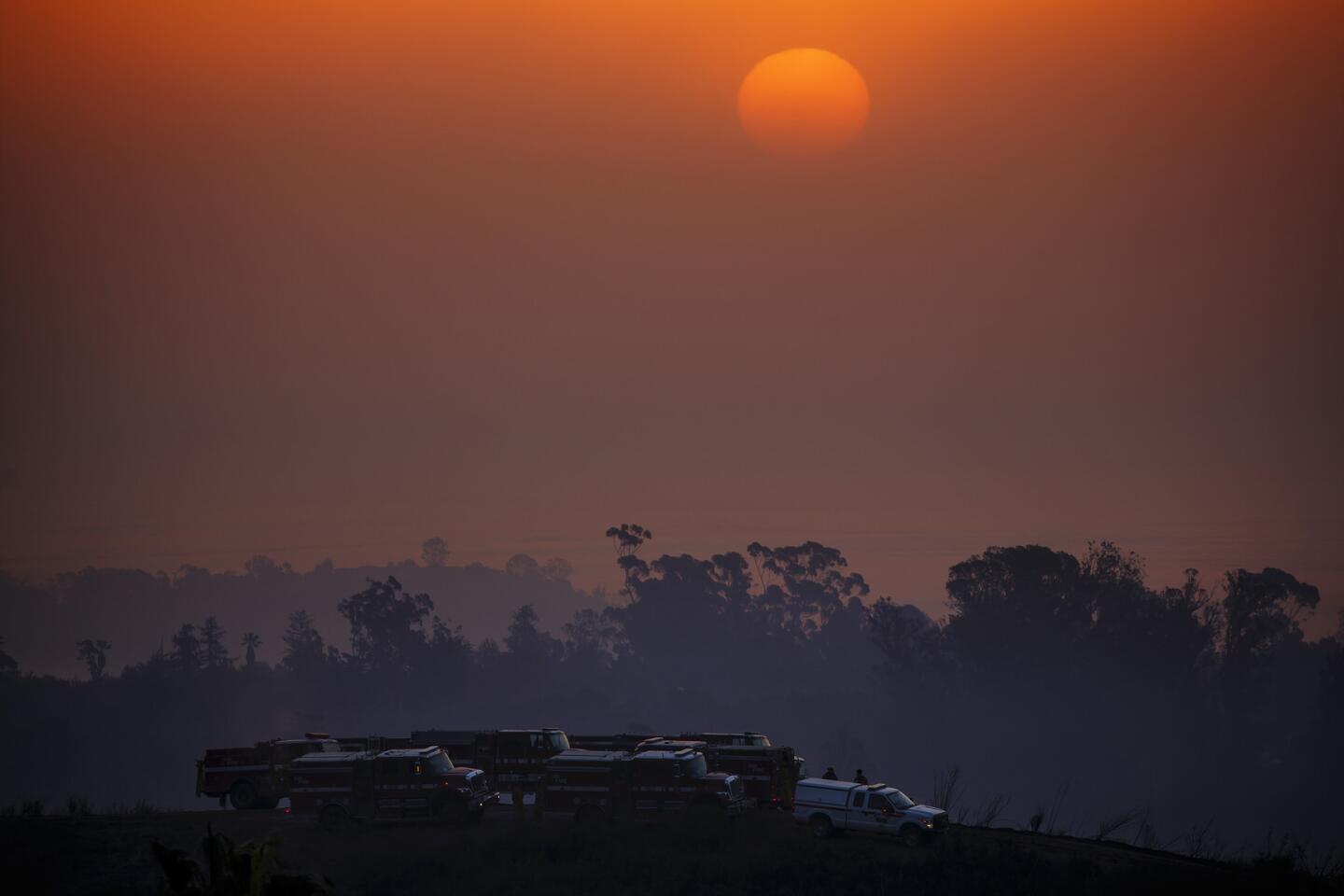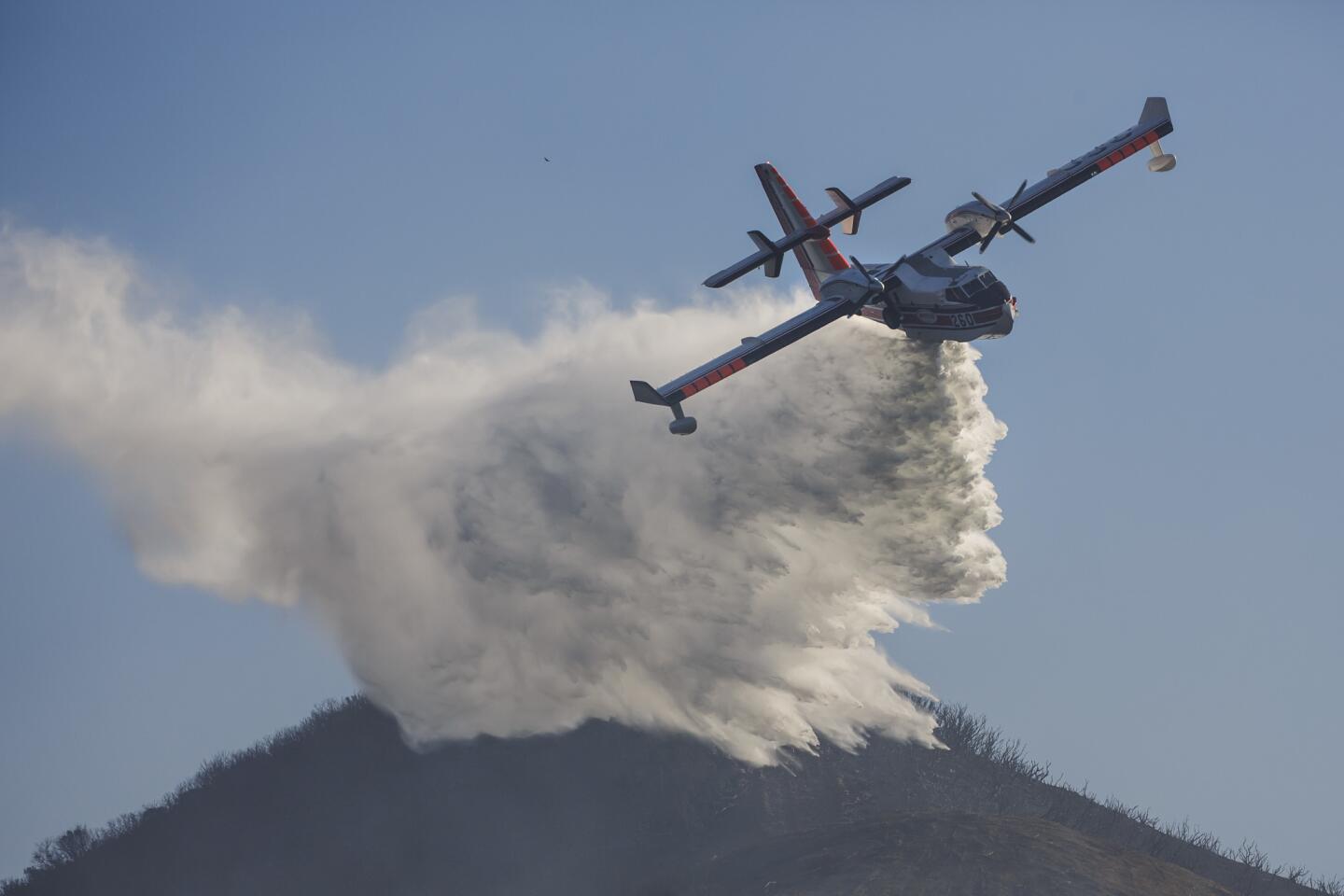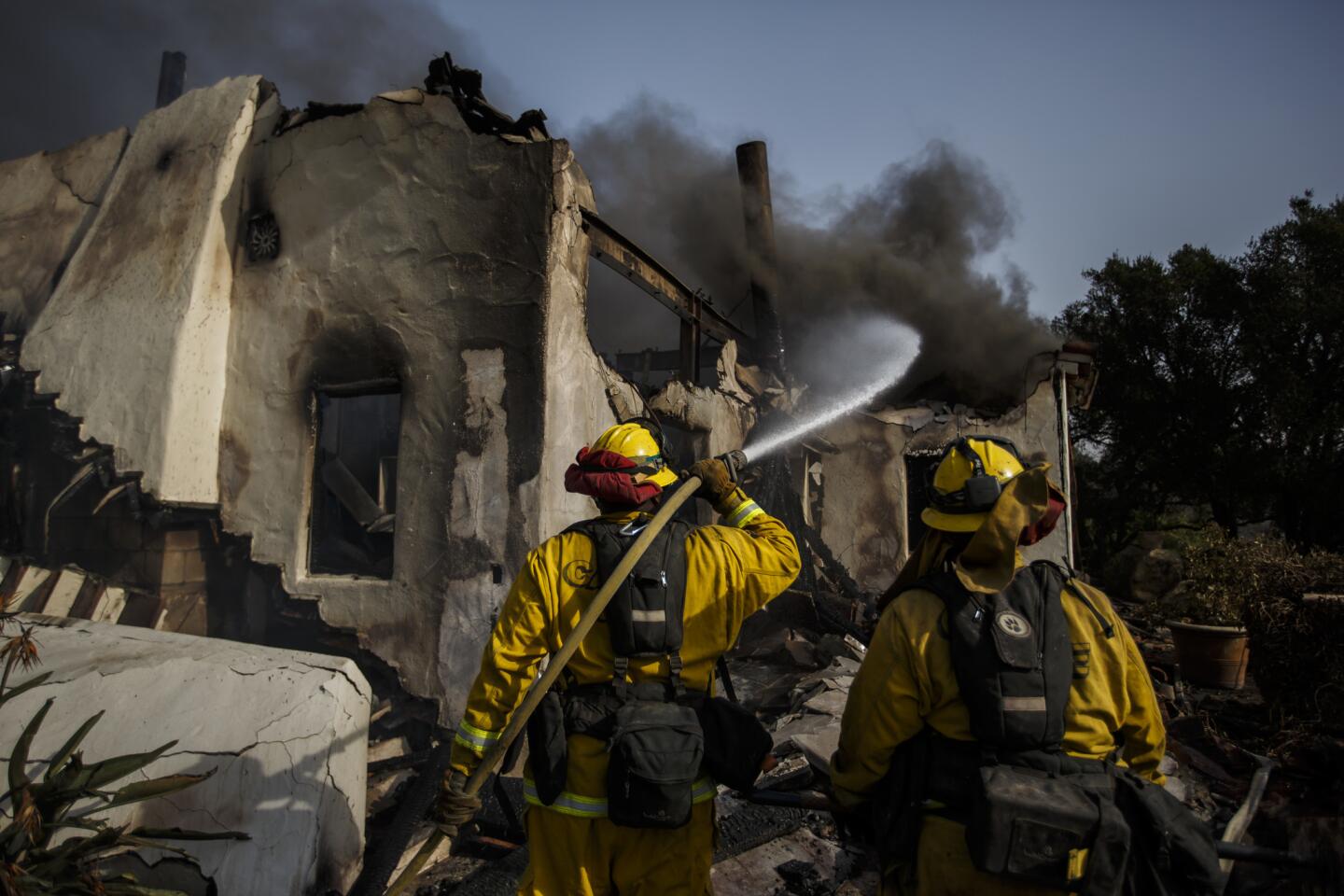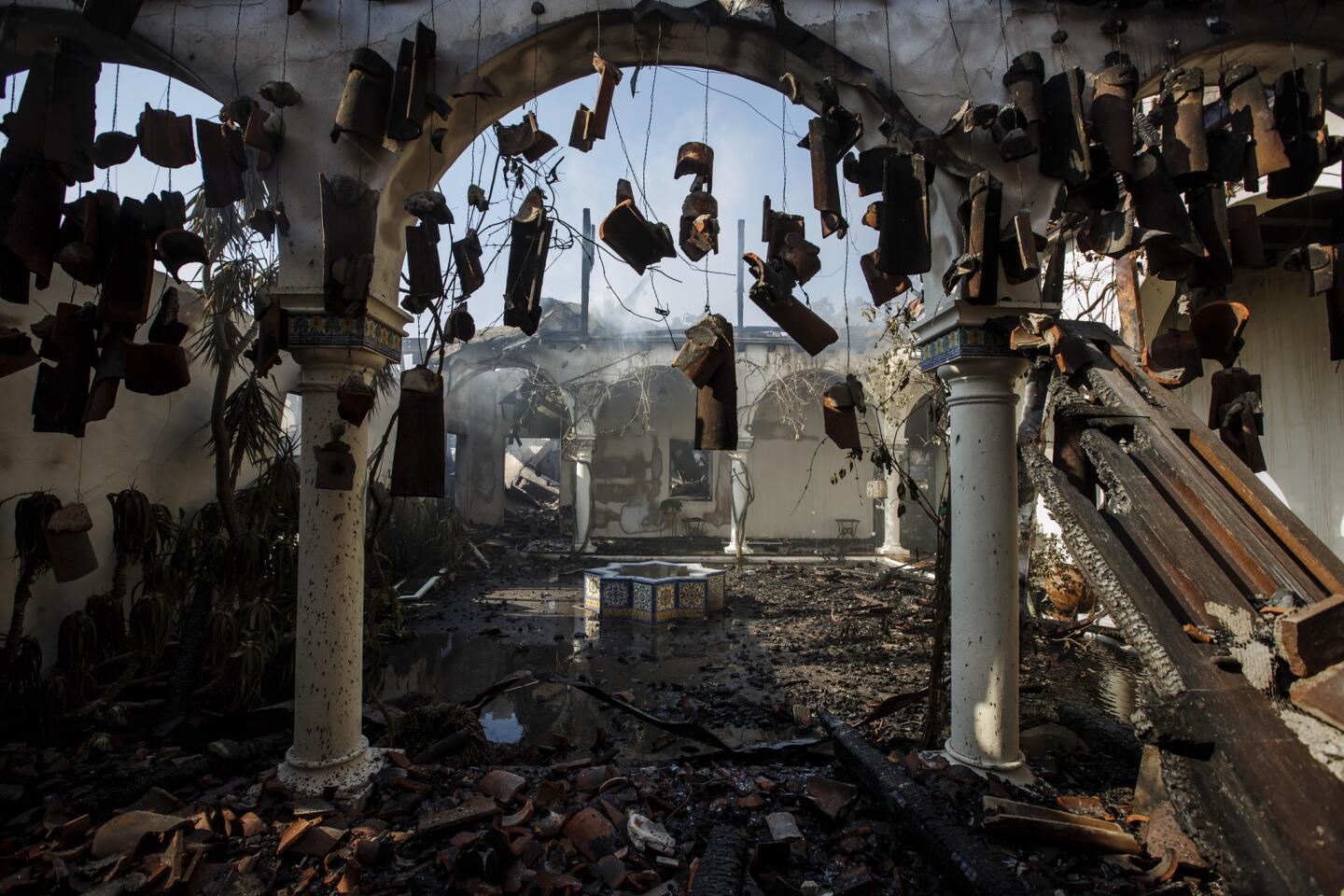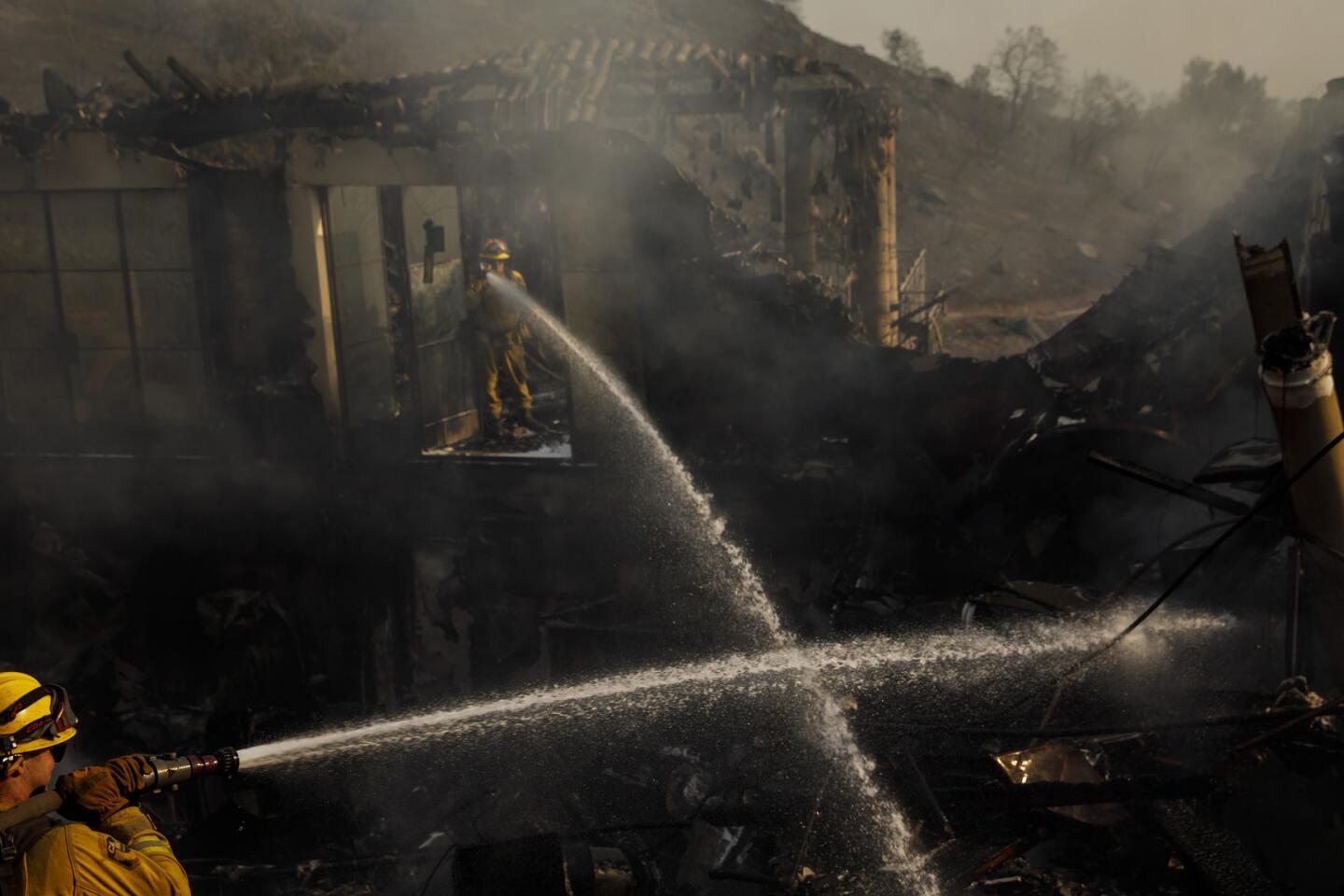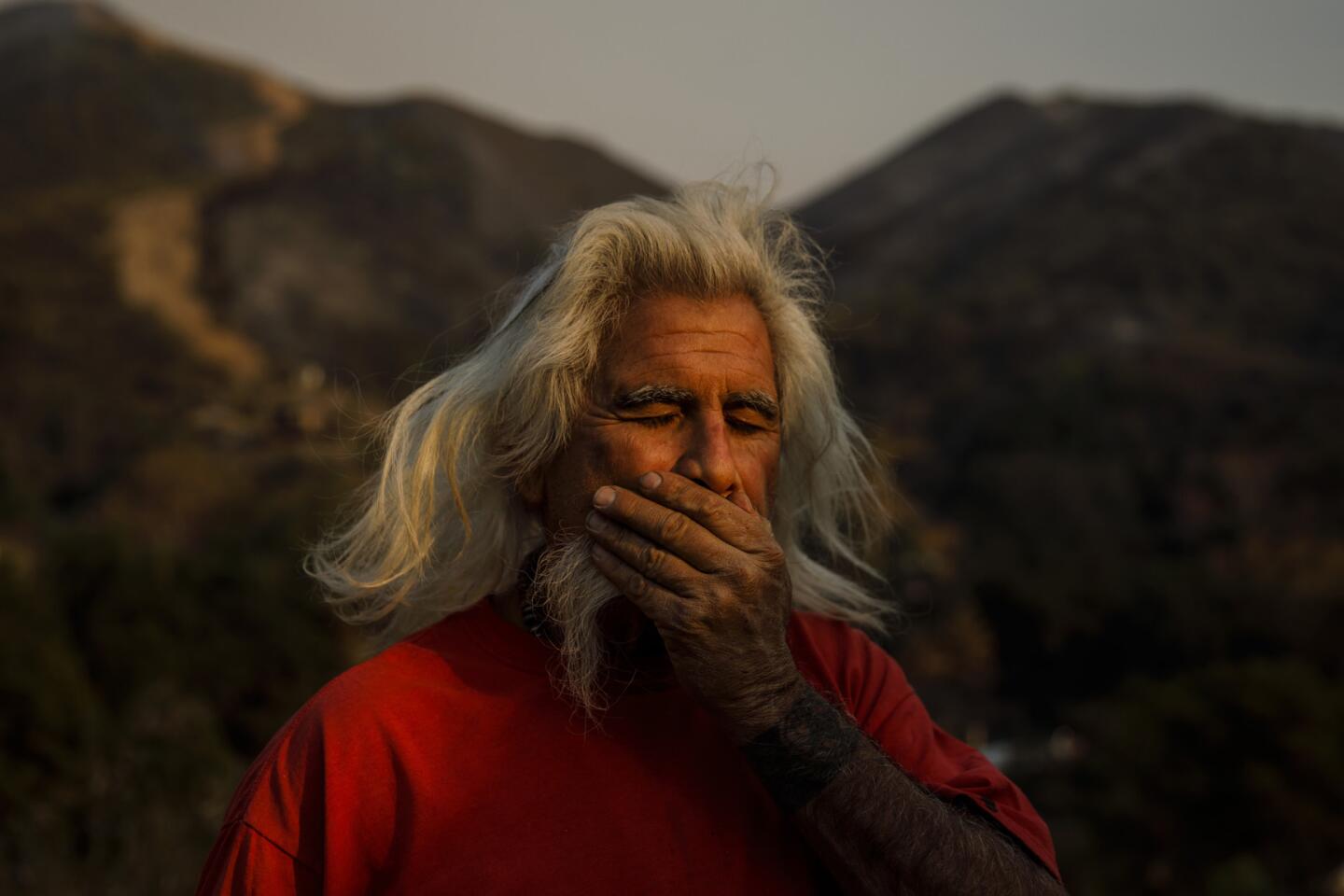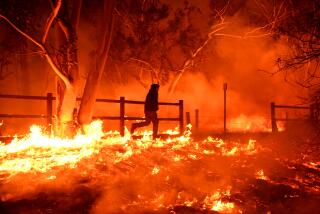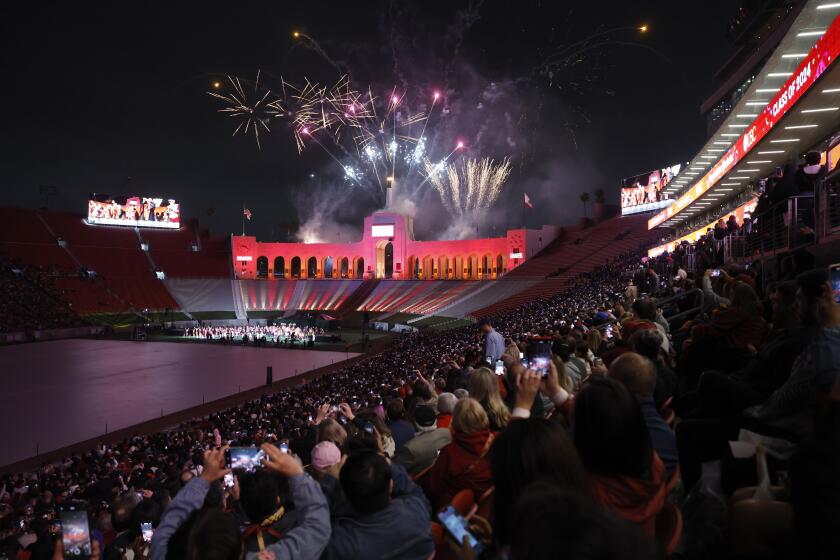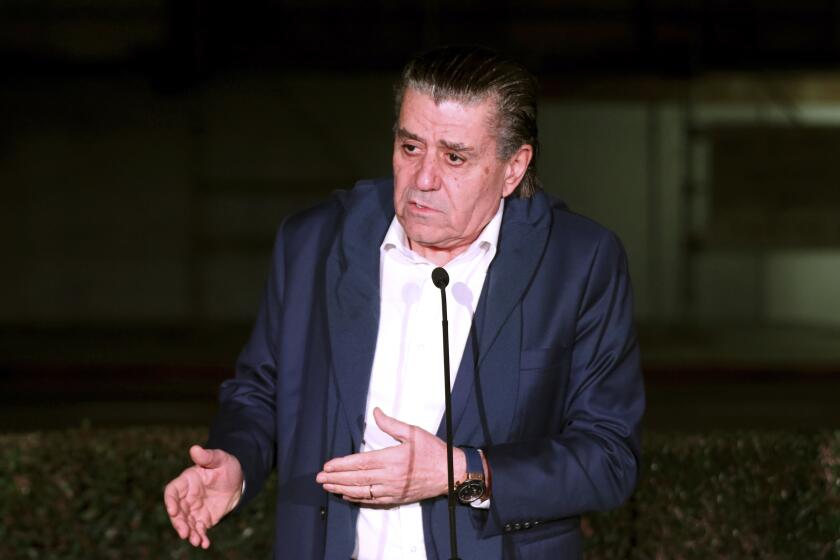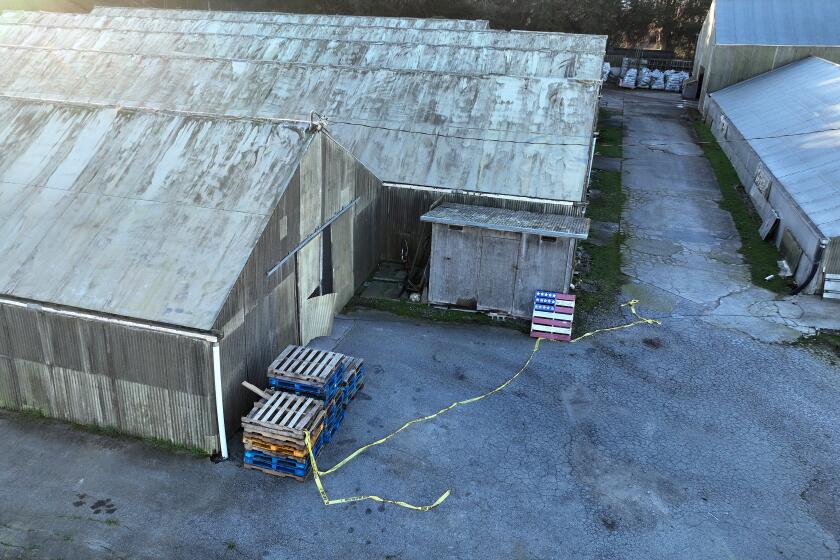Ever since the Thomas fire erupted Dec. 4, it has steadily burned its way up the list of California’s largest wildfires since the Great Depression.
That list, however, does not include what some consider to be California’s largest known wildfire — the 1889 Santiago Canyon fire, which scorched 300,000 acres in Orange, Riverside and San Diego counties.
The official California Department of Forestry and Fire Protection list of the top 20 wildfires dates back only to 1932, because records before then “are less reliable,” the department says. The largest fire on the list is the 2003 Cedar fire, which burned more than 273,000 acres and killed 15 people.
By Saturday, the Thomas fire had burned 267,500 acres in Ventura and Santa Barbara counties and was 40% contained. It rose from fourth-largest to third-largest fire on record in the state.
The Thomas fire is notable not just for its destructiveness but also for how it has continued to threaten communities for nearly two weeks, first in Ventura and Santa Paula, then Ojai and now the Santa Barbara coast.
And with winds pushing the flames this weekend, it could ultimately grow larger than the epic Santiago Canyon fire.
“The Thomas fire is still going and it potentially could exceed that 300,000-acre estimate,” said Jon Keeley, a research ecologist with the U.S. Geological Survey and an adjunct professor at UCLA. “It could end up being the biggest fire.”
1/73
John Bain and Brandon Baker try to stop a fire from burning a stranger’s home in Ventura.
(Marcus Yam / Los Angeles Times) 2/73
A brush fire moving with the wind sends embers all over residential neighborhoods north of Ventura.
(Marcus Yam / Los Angeles Times) 3/73
A family packs up and evacuates as a brush fire gets closer to their home in Ventura.
(Marcus Yam / Los Angeles Times) 4/73
John Bain and his friends, all from Camarillo, came to help as brush fires move quickly through residential neighborhoods in Ventura.
(Marcus Yam / Los Angeles Times) 5/73
Strangers band together to help put out a palm tree on fire and stop it from burning homes.
(Marcus Yam / Los Angeles Times) 6/73
The Hawaiian Gardens apartments burn in Ventura.
(Michael Owen Baker / For the Times) 7/73
Residents help with the fire attack on Buena Vista Street in Ventura.
(Michael Owen Baker / For the Times) 8/73
Residents watch the Thomas fire on Prospect Street in Ventura.
(Michael Owen Baker / For the Times) 9/73
Firefighters are deployed to battle the fire in a Ventura neighborhood.
(Marcus Yam / Los Angeles Times) 10/73
A chimney is all that stands of a home as a brush fire continues to threaten other homes in Ventura.
(Marcus Yam / Los Angeles Times) 11/73
Remnants of a home as a brush fire continues to threaten other homes in Ventura.
(Marcus Yam / Los Angeles Times) 12/73
A home burns on a hillside overlooking Ventura.
(Marcus Yam / Los Angeles Times) 13/73
Palms are consumed in the Thomas fire.
(Marcus Yam / Los Angeles Times ) 14/73
Emma Jacobson, 19, center, gets a hug from a neighbor after her family home was destroyed by fire in Ventura.
(Marcus Yam / Los Angeles Times) 15/73
Olivia Jacobson, 16, wipes tears as she looks at her family’s home, destroyed by the brush fire on Island View Drive in Ventura.
(Marcus Yam / Los Angeles Times) 16/73
Aerial view of the Thomas fire in Ventura County.
(Brian van der Brug / Los Angeles Times) 17/73
Noah Alarcon carries a cage with the family cat while evacuating from Casitas Springs.
(Michael Owen Baker / For the Times) 18/73
Smoke from the Thomas fire crosses over Lake Casitas near Ojai.
(Michael Owen Baker / For the Times) 19/73
A Ventura County firefighter battles a blaze on Cobblestone Drive near Foothill Road in Ventura.
(Al Seib / Los Angeles Times) 20/73
Ventura County Firefighter Aaron Cohen catches his breath after fighting to save homes along Cobblestone Drive near Foothill Road in Ventura.
(Al Seib / Los Angeles Times) 21/73
Aerial view of homes burned to the ground in the Thomas fire in Ventura County.
(Brian van der Brug / Los Angeles Times ) 22/73
A home between Via Baja and Foothill Road burns in Ventura.
(Al Seib / Los Angeles Times) 23/73
Amanda Leon and husband Johnny Leon watch as firefighters fight to save homes along Cobblestone Drive near Foothill Road in Ventura.
(Al Seib / Los Angeles Times) 24/73
Chino Valley firefighters fight to save a home along Cobblestone Drive near Foothill Road in Ventura.
(Al Seib / Los Angeles Times) 25/73
Embers continue to burn at sunset Tuesday in a home on Ridgecrest Court at Scenic Way in the Clearpoint neighborhood of Ventura.
(Al Seib / Los Angeles TImes) 26/73
A firefighter battles the Thomas fire along Highway 33 in Casitas Springs.
(Wally Skalij / Los Angeles Times) 27/73
Firefighters try to protect homes from the Thomas fire along Highway 33 in Casitas Springs.
(Wally Skalij / Los Angeles Times) 28/73
A firefighter battles the Thomas fire along Highway 33 in Casitas Springs.
(Wally Skalij / Los Angeles Times) 29/73
Edward Aguilar runs through the flames of the Thomas Fire to save his cats at his mobile home along Highway 33 in Casitas Springs in Ventura County.
(Wally Skalij / Los Angeles Times) 30/73
Jeff Lipscomb, left, Gabriel Lipscomb, 17, center, and Rachel Lipscomb, 11, look for items to recover from their burned home in Ventura.
(Marcus Yam / Los Angeles Times) 31/73
A traffic collision temporarily clogged lanes on the northbound 101 Freeway between Solimar and Faria Beaches as the Thomas fire burned in the hills.
(Al Seib / Los Angeles Times) 32/73
The Thomas fire burns towards the 101 Freeway and homes between Solimar and Faria Beaches.
(Al Seib / Los Angeles Times) 33/73
Fire personnel keep an eye on the Thomas fire on Toland Road near Santa Paula.
(Michael Owen Baker / For the Times) 34/73
A train on the Rincon coast passes a burning hillside from the Thomas fire.
(Michael Owen Baker / For the Times) 35/73
The Thomas fire burns along the 101 Freeway north of Ventura on Wednesday evening.
(Wally Skalij / Los Angeles Times) 36/73
A firefighter battles the Thomas fire in the town of La Conchita early Thursday.
(Wally Skalij / Los Angeles Times) 37/73
A resident cries as the Thomas fire approaches the town of La Conchita early Thursday.
(Wally Skalij / Los Angeles Times) 38/73
Burned palm trees are left standing between the 101 Freeway and Faria Beach as the Thomas fire reaches the Pacific Ocean.
(Al Seib / Los Angeles Times) 39/73
Firefighters battle Thursday to protect the resort city of Ojai from encroaching flames.
(Marcus Yam / Los Angeles Times) 40/73
Casey Rodriquez helps a friend move belongings after the Thomas Fire destroyed most of an apartment building on North Kalarama in Ventura.
(Wally Skalij / Los Angeles Times) 41/73
A burnt-out bus near Maripoca Highway.
(Marcus Yam / Los Angeles Times) 42/73
The Thomas fire burns in the Los Padres National Forest, near Ojai.
(Marcus Yam / Los Angeles Times) 43/73
A huge plume of smoke rises north of Ventura as seen Sunday afternoon from the Ventura pier, as the Thomas fire threatens parts of Carpenteria and Montecito.
(Al Seib / Los Angeles Times) 44/73
The Thomas Fire burns in the Los Padres National Forest, near Ojai, Calif. on Friday.
(Marcus Yam / Los Angeles Times) 45/73
Residents react as they watch the Thomas Fire burn in the hills above La Conchita at 5 am Thursday moning.
(Wally Skalij / Los Angeles Times) 46/73
Mary McEwen and husband Dan Bellaart prepare to evacuate their home on Toro Canyon Road in Montecito as the Thomas fire burns.
(Mel Melcon / Los Angeles Times) 47/73
Carpenteria resident Chris Gayner, right, photographs a plane in the hills of Carpenteria.
(Mel Melcon / Los Angeles Times) 48/73
From left, residents Michael Desjardins, his neighbor Patty Rodriguez, daughter Mikayla, wife Veronica, mother in law Amanda Buzin, and son Mikey keep an eye on the Thomas fire in Carpenteria.
(Mel Melcon / Los Angeles Times) 49/73
Mary McEwen cheers as she sees fire crews make their way up a hill past her home on Toro Canyon Rd. in Montecito.
(Mel Melcon / Los Angeles Times) 50/73
Dan Bellaart and wife Mary McEwen comfort each other in the backyard of their home that includes an avocado ranch on 9 acres of land on Toro Canyon Road in Montecito, as the Thomas fire burns in the background.
(Mel Melcon / Los Angeles Times) 51/73
Carpinteria resident Jay Molnar, 55, mouth and nose protected against the smoke, views flames glowing in the hills above the city on Dec. 11, 2017.
(Mel Melcon / Los Angeles Times) 52/73
Sacramento firefighters battle a blaze in Toro Canyon in Carpenteria at dusk Tuesday.
(Al Seib / Los Angeles Times) 53/73
Josh Acosta, superintendent with Fulton Hotshots looks for ways to fight fire consuming a structure threatening two homes high up Toro Canyon in Carpenteria at dusk Tuesday.
(Al Seib / Los Angeles Times) 54/73
A motorcade passes on tHighway 126 carrying the body of a Cal Fire engineer Cory Iverson, who died Thursday morning while battling the Thomas Fire.
(Al Seib / Los Angeles Times) 55/73
Santa Paula City officials, Police and Firefighters salute from a bridge as a motorcade passes on the Santa Paula Freeway 126 carrying the body of a Cal Fire engineer Cory Iverson.
(Al Seib / Los Angeles Times) 56/73
Forest Service crews cut and clear dense brush for contingency lines off of East Camino Cielo in the Santa Ynez Mountains above Montecito and Santa Barbara to help stop the Thomas fire from advancing.
(Al Seib / Los Angeles Times) 57/73
A hotshot crew from Ojai marches towards their assignment to protect structures on East Mountain Drive in Montecito.
(Marcus Yam / Los Angeles Times) 58/73
Firefighters monitor the flames Saturday from a staging area near Parma Park in Montecito.
(Marcus Yam / Los Angeles Times) 59/73
Flames slowly make their way down a valley behind a home in Montecito.
(Marcus Yam / Los Angeles Times) 60/73
Flames whip around power lines as they move through Sycamore Canyon on Saturday, threatening structures in Montecito.
(Marcus Yam / Los Angeles Times) 61/73
Smoke billows over Santa Barbara as the Thomas Fire continues to threaten the area on Saturday.
(Robert Gauthier / Los Angeles Times) 62/73
Bill Shubin, deputy fire chief of the Santa Rosa Fire Department checks on flames burning near homes north of East Mountain Drive in Montecito.
(Marcus Yam / Los Angeles Times) 63/73
A fire truck pulls responds to fires burning near homes on East Mountain Drive in Montecito.
(Marcus Yam / Los Angeles Times ) 64/73
Brian Good, from US Forest Service, leans forward against the wind, and holds up a Kestrel to measure wind speeds up to 50 mph on Gibraltar Road in Montecito.
(Marcus Yam / Los Angeles Times) 65/73
A plume of smoke moves south as winds as high as 50 mph blow down Gibraltar Road on the west fork of Cold Spring Trail in Montecito.
(Marcus Yam / Los Angeles Times) 66/73
Flames and a big plume of smoke threaten homes on Gibraltar Road near Gibraltar Rock, outside Montecito.
(Marcus Yam / Los Angeles Times) 67/73
The sun rises as fire crews prepare for another day of fighting the Thomas Fire, in Montecito, Calif., on Sunday.
(Marcus Yam / Los Angeles Times) 68/73
An aircraft makes a water drop over a hot spot up in the mountain range at Gibraltar Rock near Montecito, Calif. on Sunday.
(Marcus Yam / Los Angeles Times) 69/73
Humboldt County firefighters Bobby Gray, left, hoses down smoldering flames inside a destroyed home, as Kellee Stoehr, right looks on, after the Thomas Fire burned in Montecito, Calif. on Sunday.
(Marcus Yam / Los Angeles Times) 70/73
A home on Park Hill Lane was destroyed by the Thomas fire in Montecito, Calif.
(Marcus Yam / Los Angeles Times ) 71/73
Humboldt County firefighters Lonnie Risling, left, and Jimmy McHaffie, right, spray down smoldering fire underneath the rubble of a home that was destroyed by the Thomas Fire, in Montecito, Calif., Sunday.
(Marcus Yam / Los Angeles Times) 72/73
Fire crews help the Behrman family retrieve their family’s personal belongings out of their burned home, in Montecito, Calif., on Sunday.
(Marcus Yam / Los Angeles Times) 73/73
In the foreground of the ridges that were burned by the Thomas Fire, Rusty Smith stands outside his home that survived the flames that were kicked up by Saturday’s wind event and threatened his home in Flores Flats on Gibraltar Road, near Montecito.
(Marcus Yam / Los Angeles Times) The year is already the most destructive in terms of fire in California history. Besides the Thomas fire, a series of wind-whipped blazes in wine country destroyed more than 10,000 homes and killed more than 40 people in October.
In the 1930s, the U.S. Forest Service compiled a list of all fires in California, with records going back to 1861, according to Keeley.
“These are estimates though, because going back that far, essentially all you have are newspaper reports,” Keeley said. “There’s been big fires off and on ever since. ... Large fires are not unknown in California by any means. The one thing that perhaps is different is we’re getting more of them now than we did historically.”
Since the Civil War, half of Southern California’s largest wildfires have occurred in the last 15 years, according to a paper written by Keeley.
The reason for the increase? Humans.
“Historically, if you look in the past when there are relatively few people on the landscape, a significant number of the fires were being started by lightning,” Keeley said. “And lightning doesn’t occur during Santa Ana wind events. There was just a much lower probability of an ignition coinciding with Santa Ana winds.”
Today, however, most fires are triggered by people.
“As people increase on the landscape, we have a much greater chance that they’re going to ignite fires. Perhaps by arson, or more people on the landscape means more infrastructure such as power lines that could cause fires. We think that the increased incidence of big fires is most directly tied to people, more people and more badly timed ignition.”
Keeley notes that the Thomas fire is a “real anomaly,” because it is tied to an unusually long Santa Ana wind event.
“Normally when we get a strong Santa Ana wind event, it lasts two or three days and then the winds die down and the fire is then contained,” Keeley said. “But this fire is occurring during a Santa Ana wind event that apparently isn’t even over yet. … The longer the Santa Ana winds blow, the larger the fire grows. That’s an important characteristic of the Thomas fire.”
The Santiago Canyon fire ignited under Santa Ana wind conditions and that was coupled with the fact that there were very few people on the landscape to fight the flames, Keeley said. Contemporary news reports said the fire began in a sheep herder’s camp.
In a recent paper on fire and climate, researchers evaluated the correlation between the number of Santa Ana wind events each year and the area burned and found no relationship.
“We get Santa Ana winds every year. It’s just, some years, somebody ignites a fire during them, and when that happens, they tend to get really large,” Keeley said. “But the really large ones, we found, were related to prior drought.”
He pointed to the 2003 Cedar fire, which was preceded with more than a year of drought.
“We think that this fire, the Thomas fire, is likely very large in part not just because the Santa Ana wind event is long, but there was this very extreme drought between 2012 and 2014.”
Drought is often thought to affect the fuel moisture of vegetation. But researchers’ analysis suggests otherwise, Keeley said.
“What extreme droughts do is they cause dieback of the vegetation,” he said. “Basically a canopy of the vegetation dies and oftentimes the entire plant dies. So you have lots of dead vegetation out on the landscape from the drought. And when the Santa Ana winds blow embers ahead of the fire front, they’ll ignite spot fires, but only if they land on dead vegetation.”
The USGS plans to study the amount of dieback that was present before the Thomas fire erupted, he said.
“I suspect there must have been a lot of dead vegetation and that enhanced that fire,” Keeley said.
brittny.mejia@latimes.com
Twitter: @brittny_mejia
UPDATES:
Saturday 2:50 p.m.: This article was updated with new statitics and light recasting.

